Phoretic is a suspended sculpture composed of ten articulated modules. In each, TPU is held in tension between polarized filters, making visible the interplay of light and material stress through shifting patterns of photoelasticity. These subtle chromatic variations expose the forces contained in the material itself, rendering tension both structural and perceptible.
Suspended like a mobile, Phoretic takes the form of a multiple body somewhere between myriapod and synthetic organism in constant suggestion of transit and motion. Its articulated modules generate a biomorphic presence, evoking both organic and mechanical associations without fully belonging to either.
The work draws from the concept of phoresy: organisms that use others as a temporary means of transport. In this case, the exhibition space itself becomes a transitional infrastructure. Phoretic does not remain static; it exists in a state of passage, carried and conditioned by its environment.
Far from passive, the piece responds to minimal changes in its surroundings. Air currents, the movement of visitors, and the modulations of light activate the work, making it sensitive to what unfolds around it. Through these subtle responses, Phoretic introduces a form of interference: it distorts the light, captures the breeze, and alters the circulation of bodies in space.
Its presence operates as a third element, neither object nor background. It redistributes flows and disrupts established dualisms, opening space for new relations to emerge. Phoretic makes noise, but at the same time, it is made by that noise. The piece suggests that such interference within a system can also become the seed of another one—where disturbance is not collapse, but the origin of a new order.
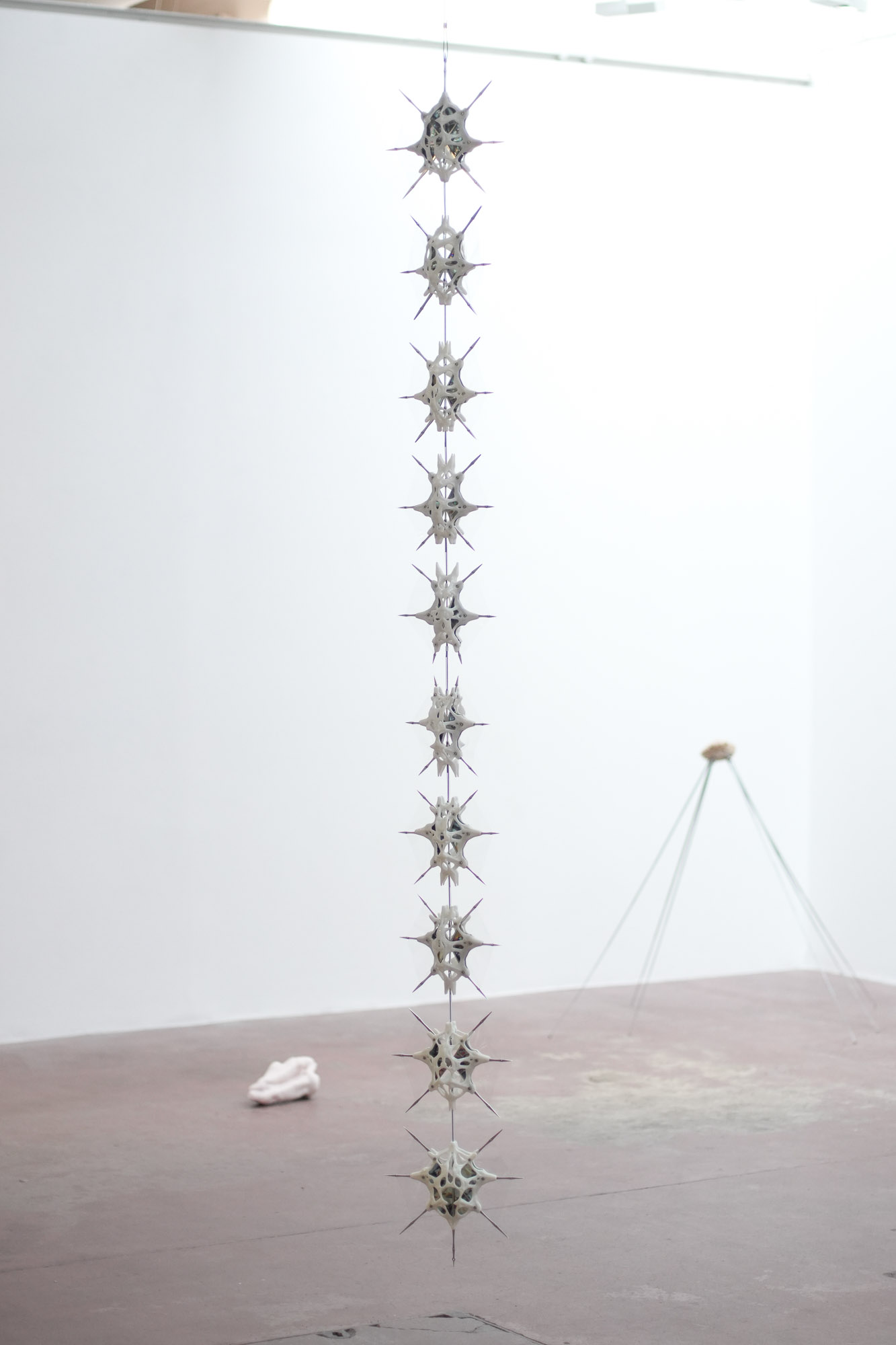
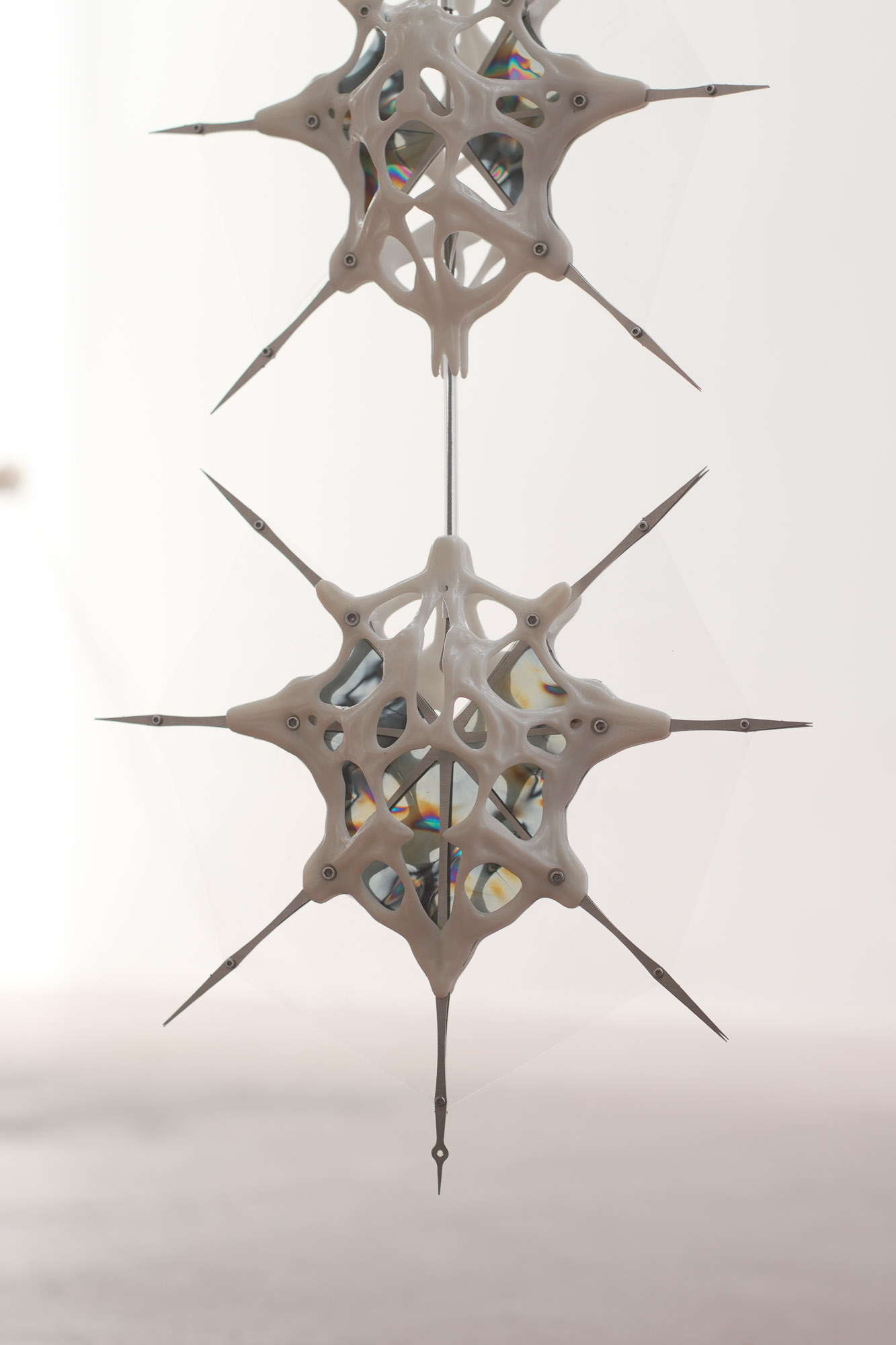
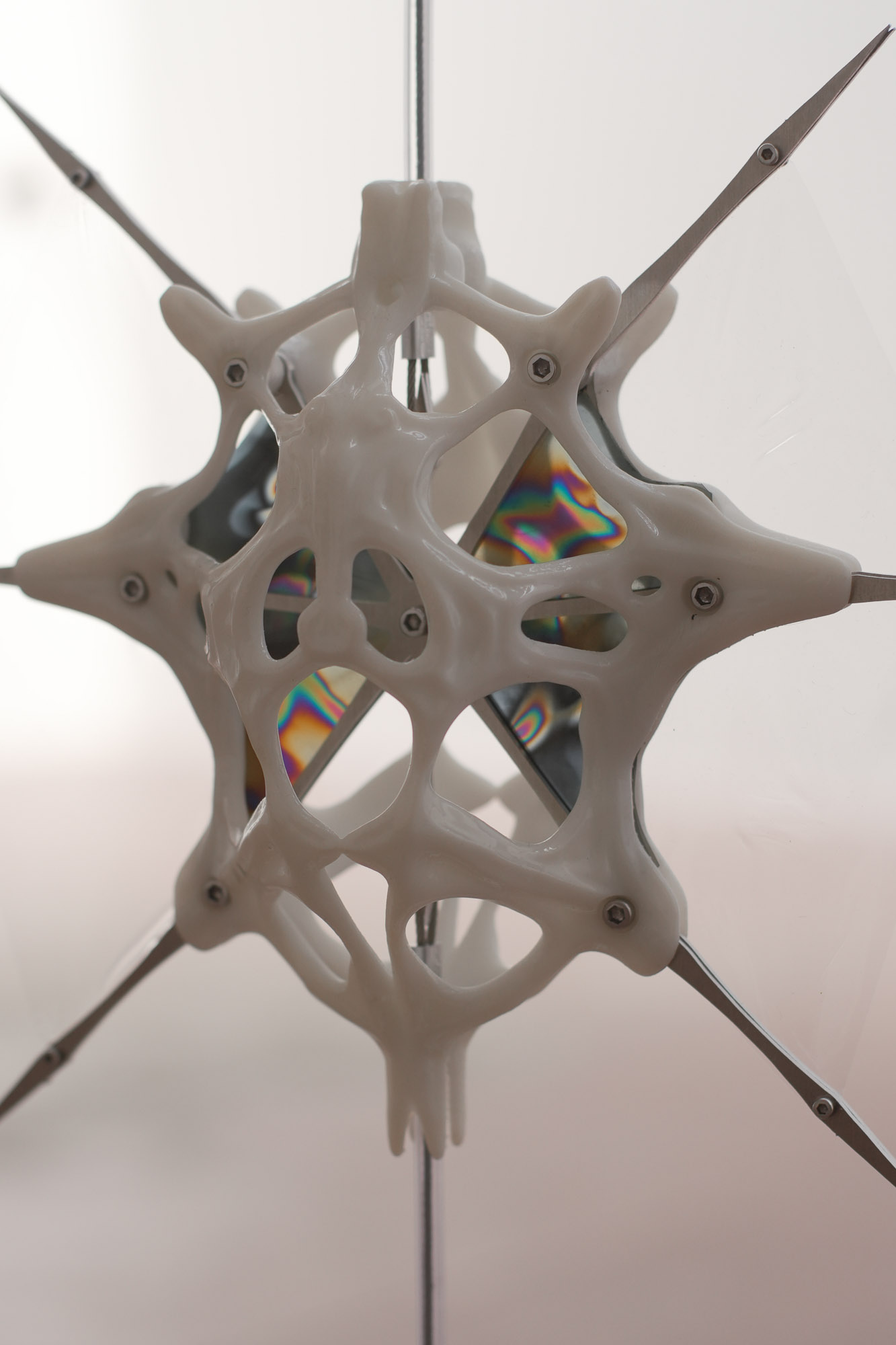
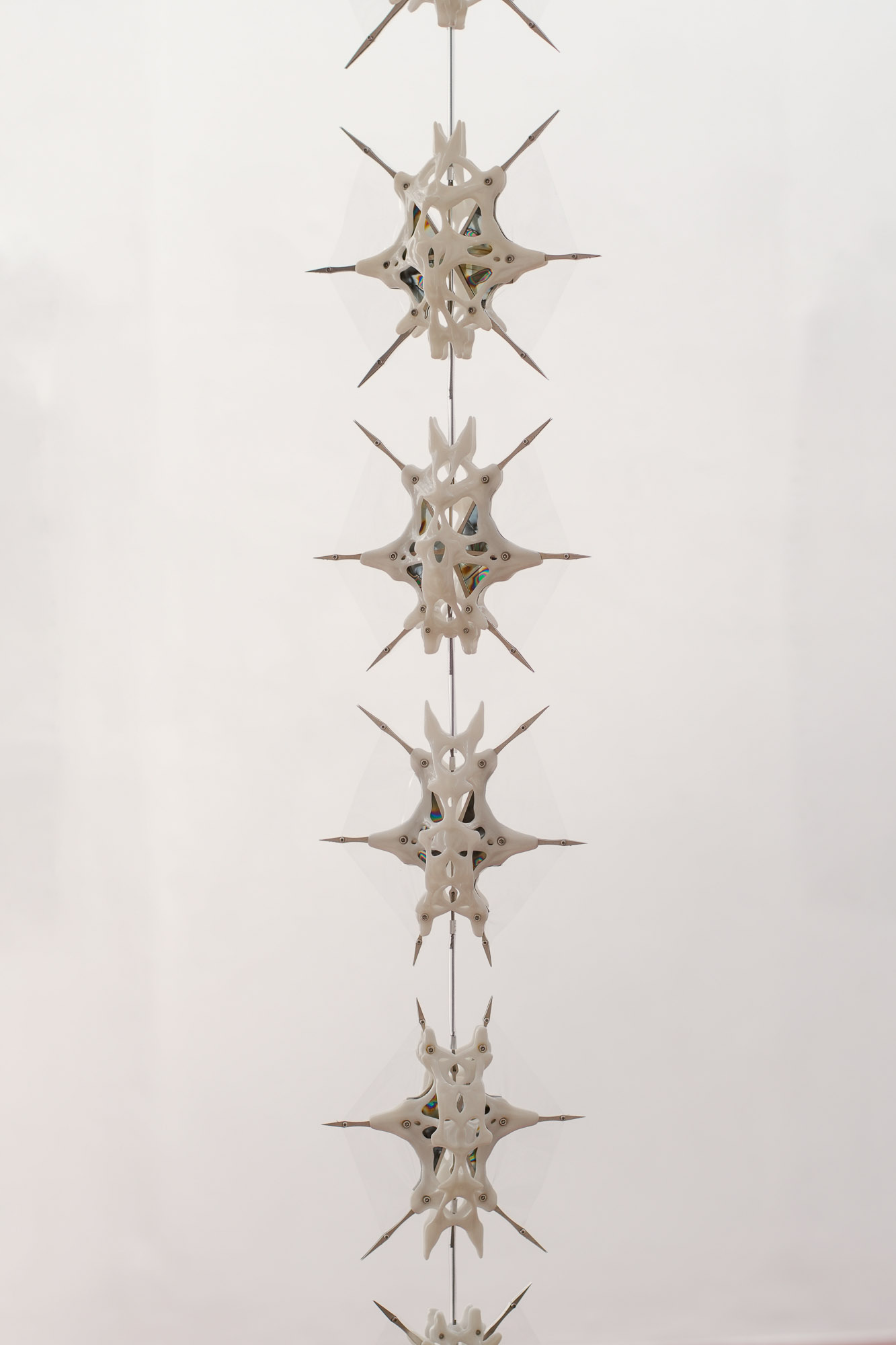
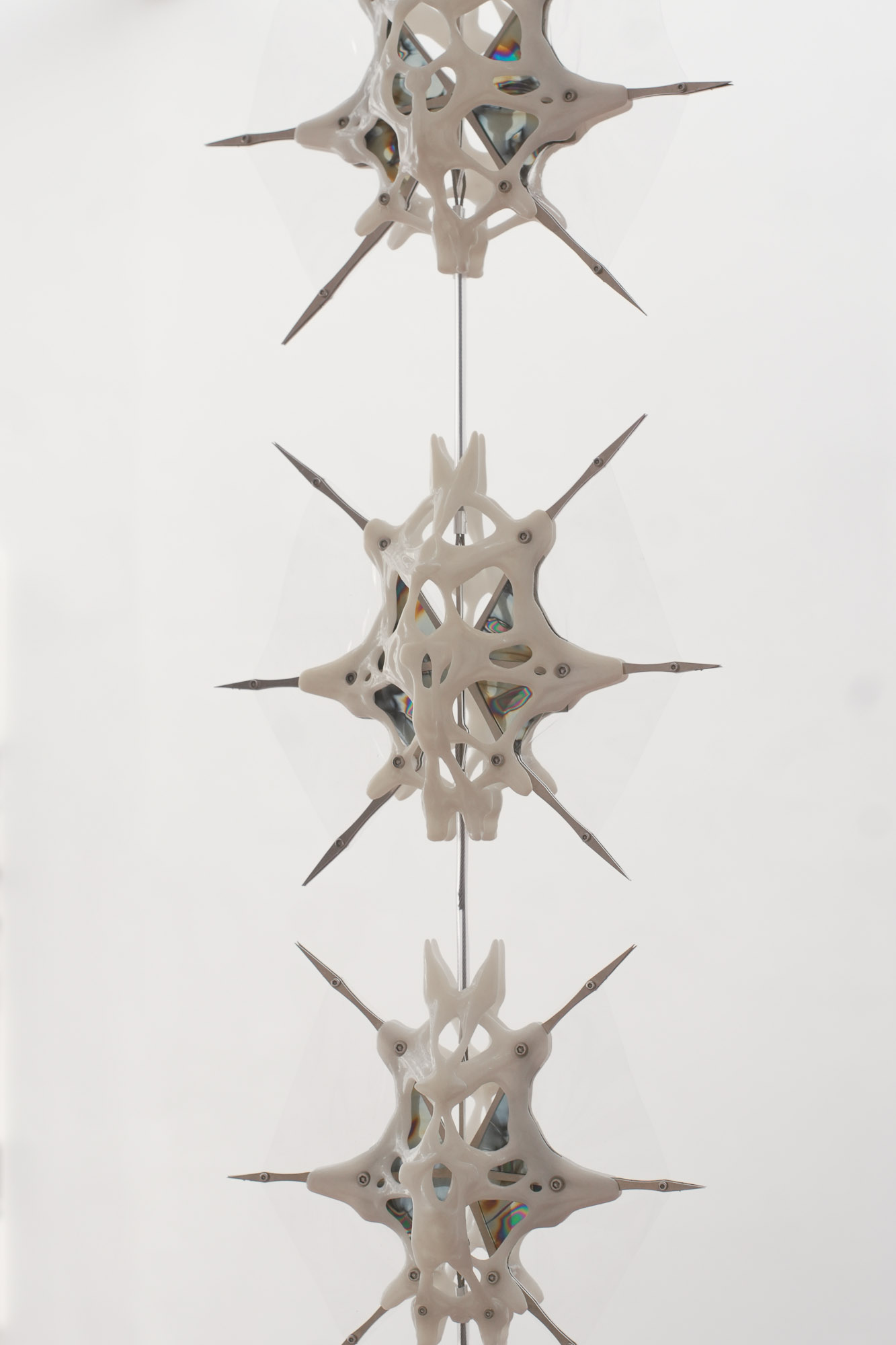
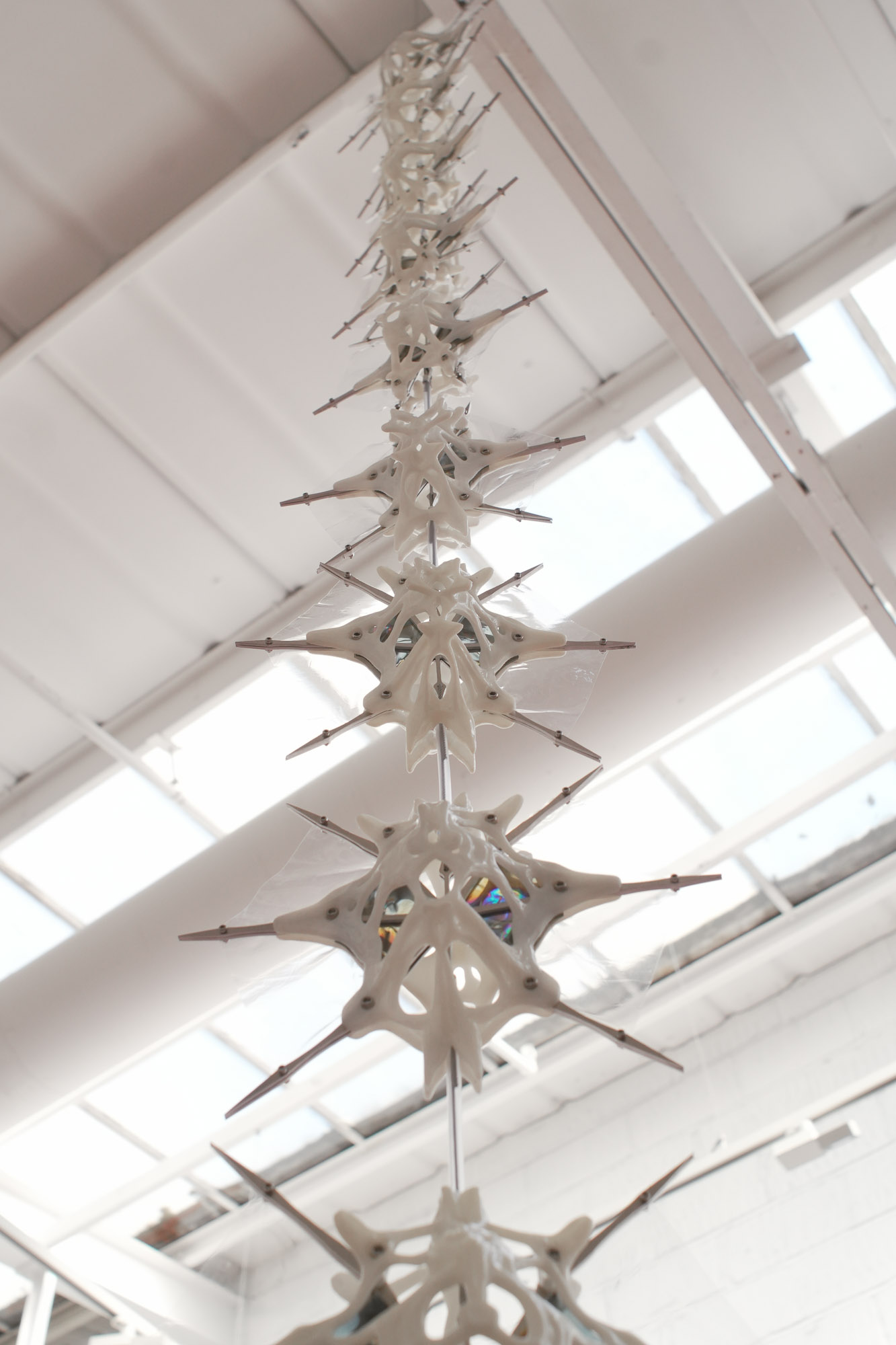
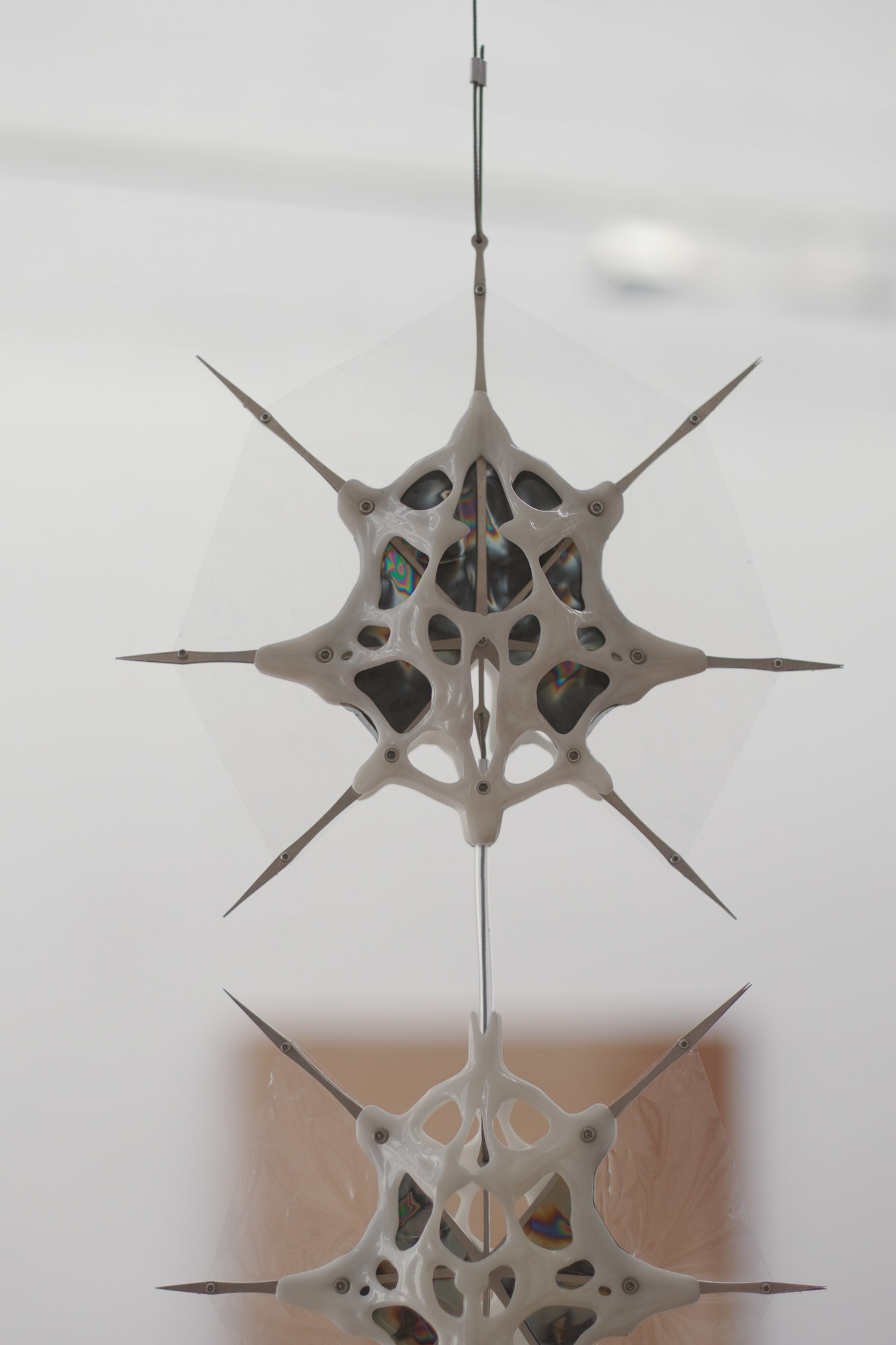
States of Tension offers a visual and material exploration of tension as a constant and inherent condition of both physical and perceptual systems. Through a TPU sheet subjected to mechanical forces and revealed by a system of polarized filters, the internal distribution of stress within the material becomes visible.
The piece moves beyond a physical display, incorporating the imprint of my own body. The gesture of manually stretching the sheet introduces a trace of tension into the material, turning the piece into a visual narrative where the mechanical and the personal intertwine, transforming it into a device of perceptual experience.
Tension is not a static state nor an isolated entity, but a dynamic force in constant fluctuation. It manifests not only in the deformation of a body under load, but also in our biological and emotional structures, regulating the fragile balance between order and chaos.
In dialogue with broader discourses on life and matter, States of Tension resonates with Schrödinger’s definition of life as the capacity to maintain order against entropy, and with Prigogine’s notion of dissipative structures, which achieve organization through instability. Within this constellation, the installation becomes more than a material experiment: it embodies the paradox of systems that exist only by sustaining tension. It is through the phenomenon of photoelasticity, revealed by polarized filters, that patterns of stress normally hidden from view are made visible.
These structures of light and color echo the invisible fields that also shape our relations. Proxemics extends this reading: our bodies generate invisible spheres of tension—intimate, personal, social—whose disruption alters emotional and relational equilibrium. In this way, the material and the social converge in a shared principle: tension as a condition of form, relation, and existence.
States of Tension is constructed as a rectangular prism made of aluminum profiles, externally clad with acrylic panels and polarizing filters. At the lower corners, four stepper motors drive linear spindles along the Z-axis, controlled by a microcontroller and four dedicated drivers. Each spindle anchors one corner of the TPU sheet, producing a coordinated yet irregular movement that allows the material to oscillate between states of rest and states of tension. The use of a programmable microcontroller introduces an additional layer of variability: parameters such as speed, amplitude, and timing can be modulated, generating rhythms that alternate between subtle vibration and sudden strain. Through the technique of photoelasticity (cross polarization), these fluctuating states become visible as chromatic interference patterns—ephemeral images of stress translated into light. This technological system thus functions not only as a mechanism for movement, but as an active interface where material, code, and perception converge, drawing the viewer into a state of attention and trance that is simultaneously physical and experiential.
This system explores how tension, in its varying intensities, can generate organized structures or induce destabilization. An increase in tension may foster cohesion and order, while its reduction tends toward disorder. Yet, excessive tension can lead to collapse, just as its complete absence may cause disintegration.
States of Tension ultimately reflects on the interplay between stability and instability, showing how tension operates simultaneously in the physical, biological, and social realms. Whether in a TPU sheet, in a living cell, or in the invisible distance between two bodies, tension emerges as a fundamental principle that shapes matter, structures, and perception.
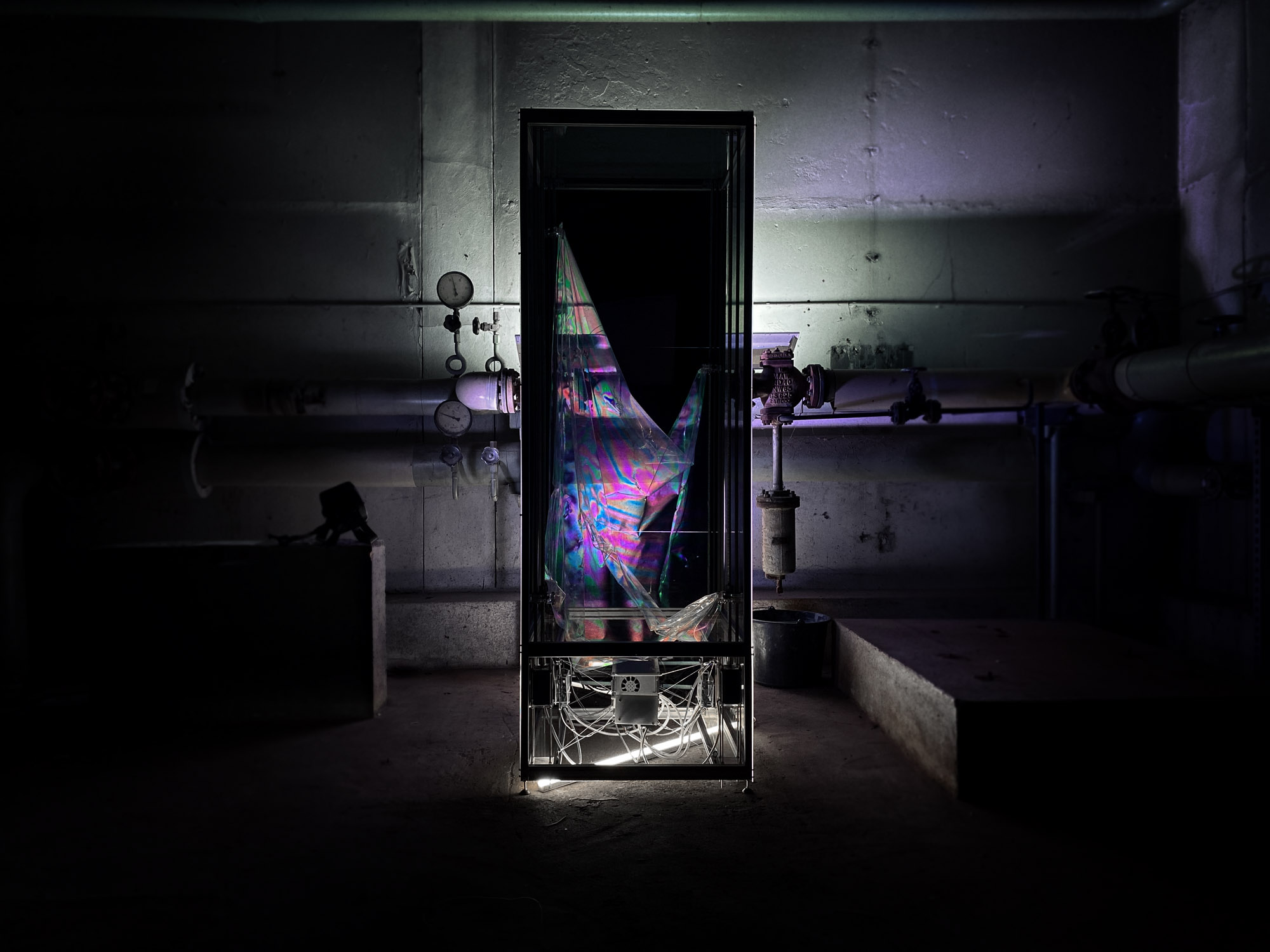
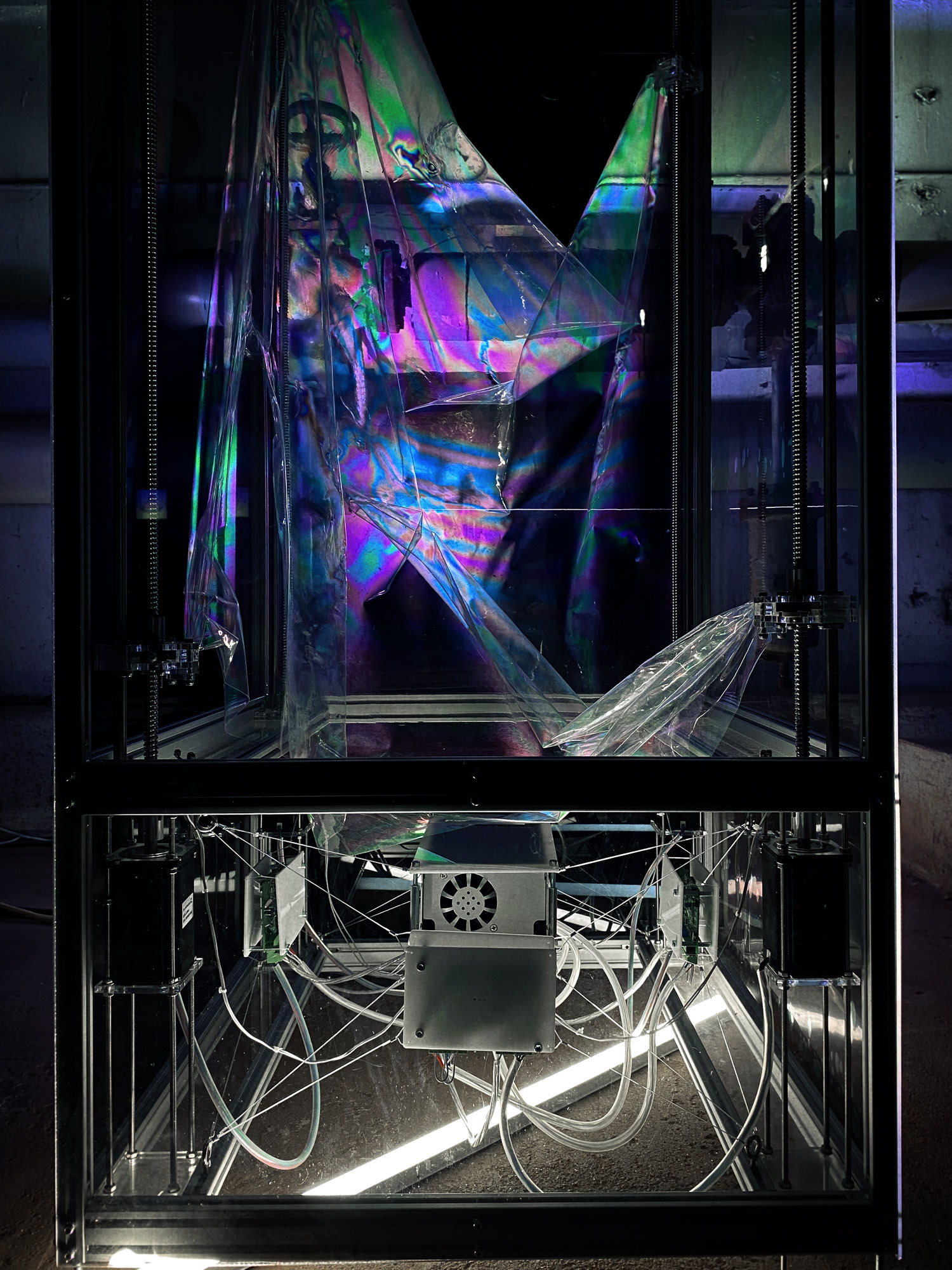
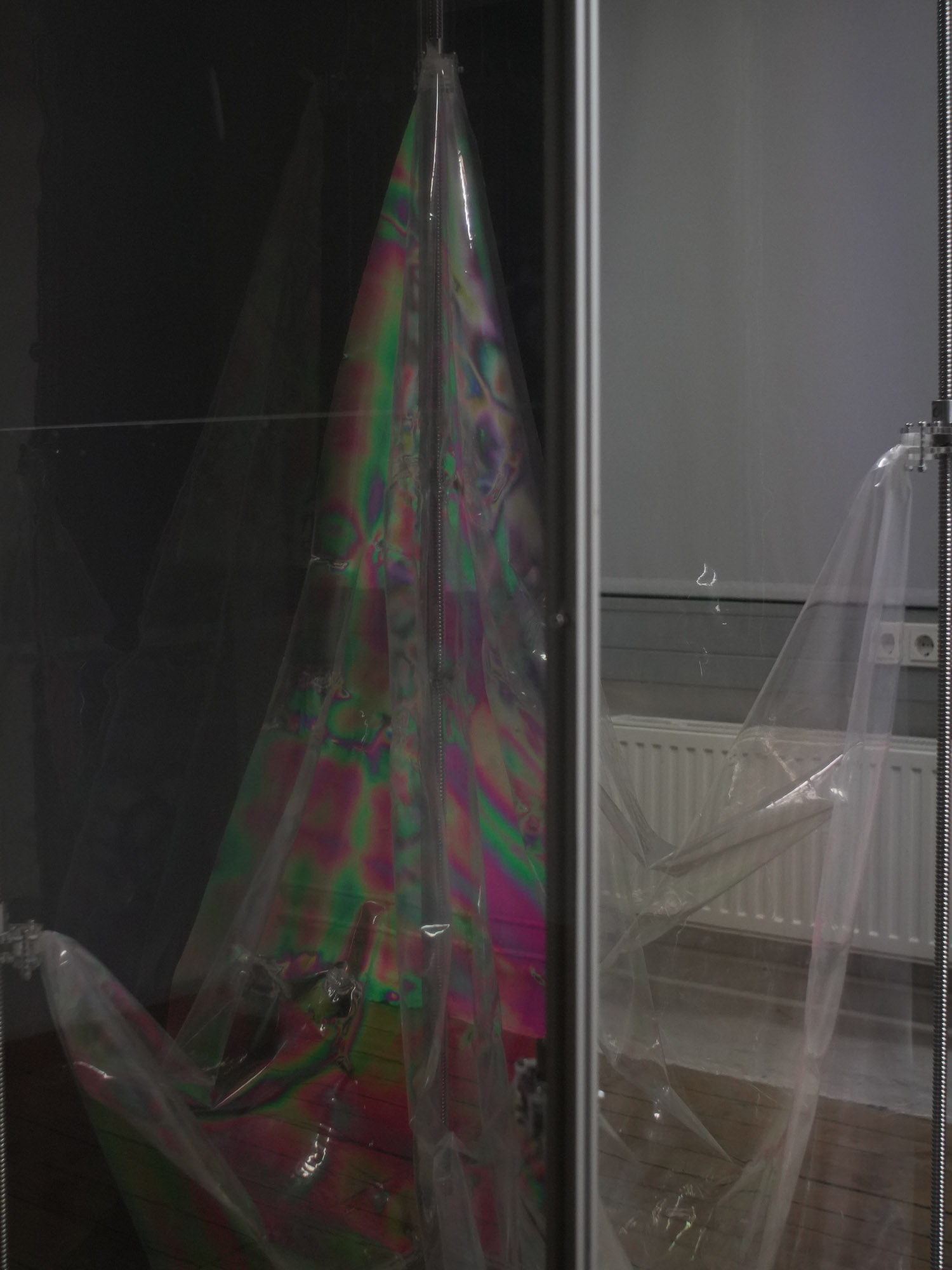
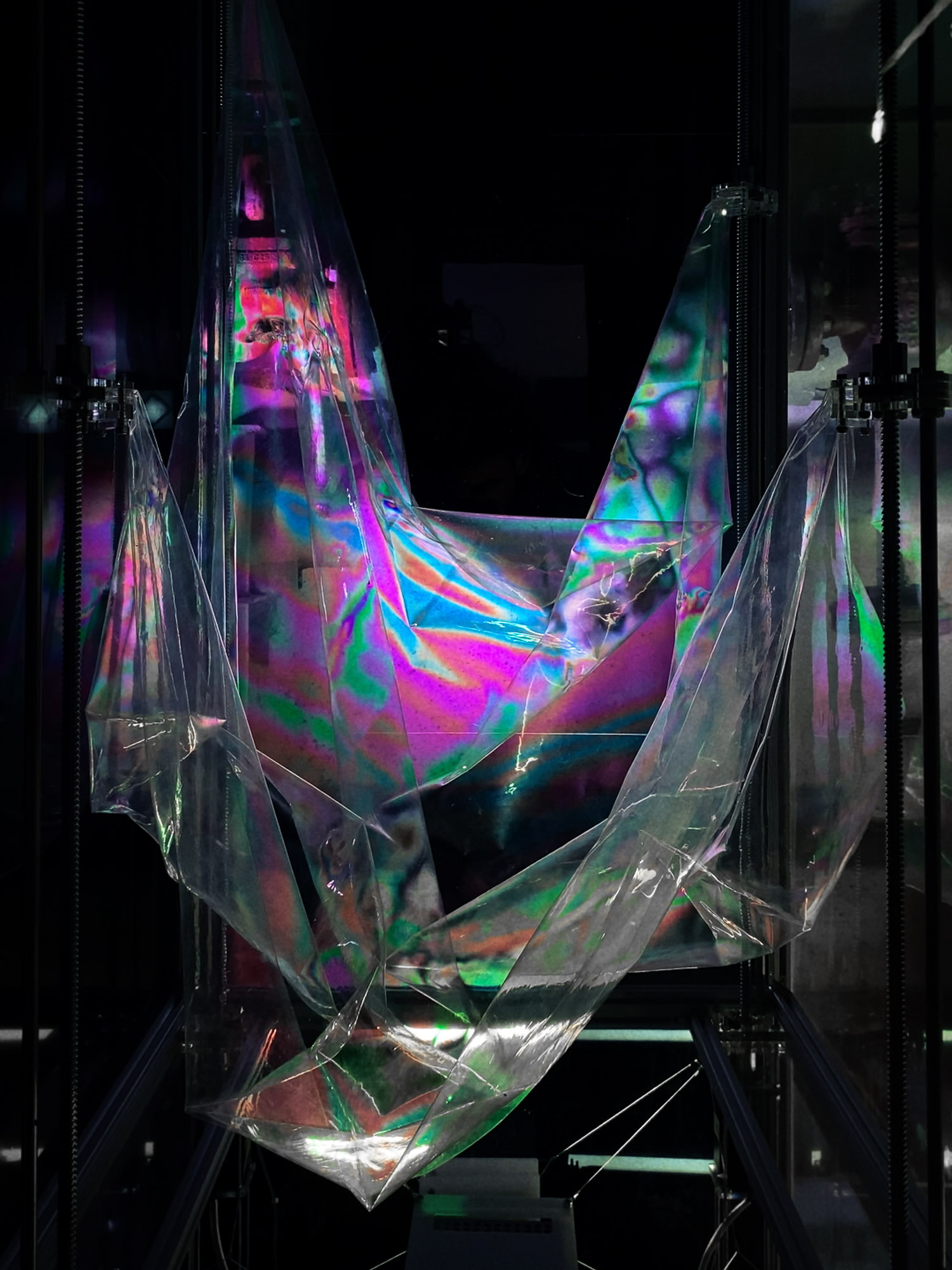
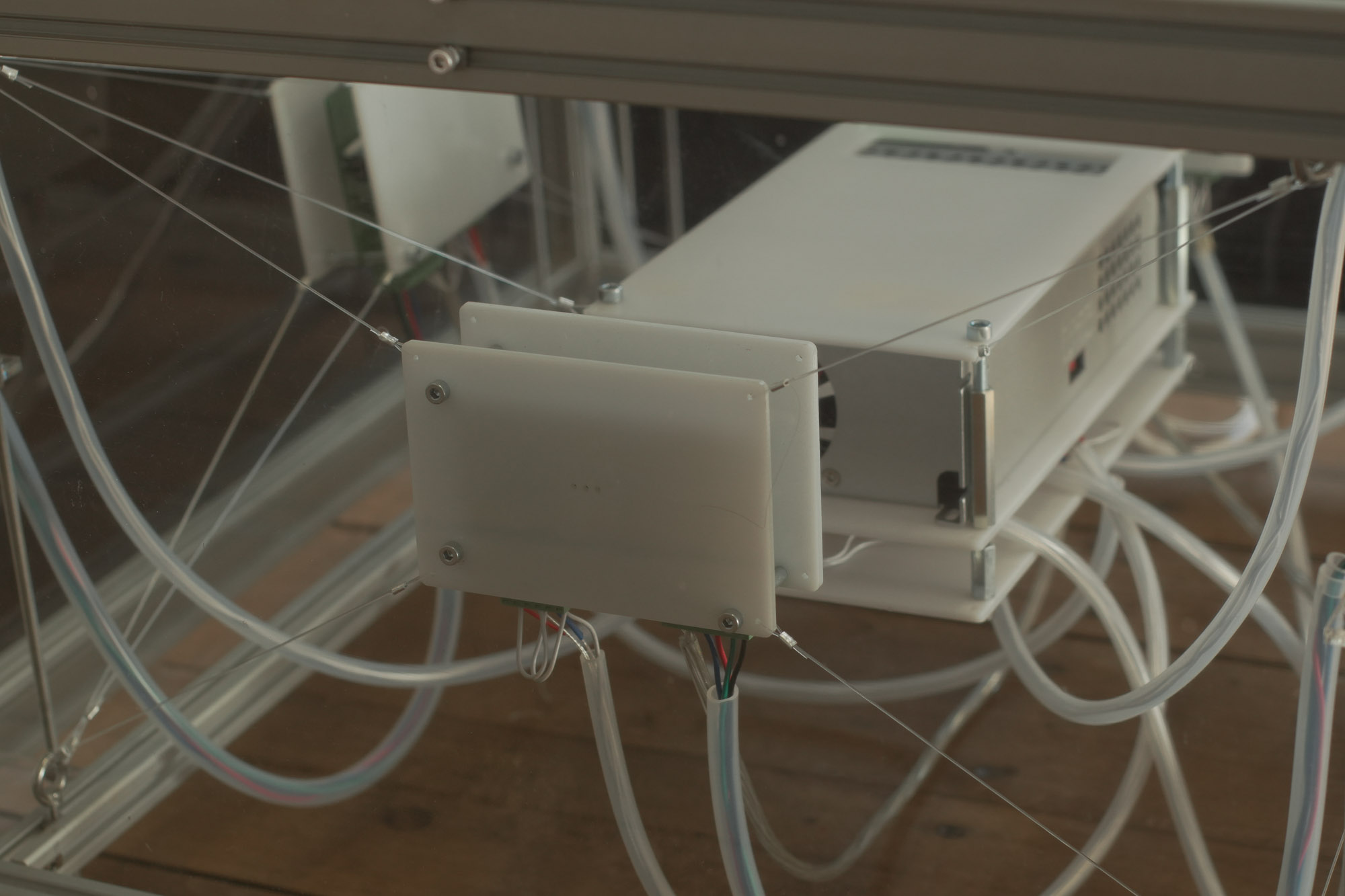
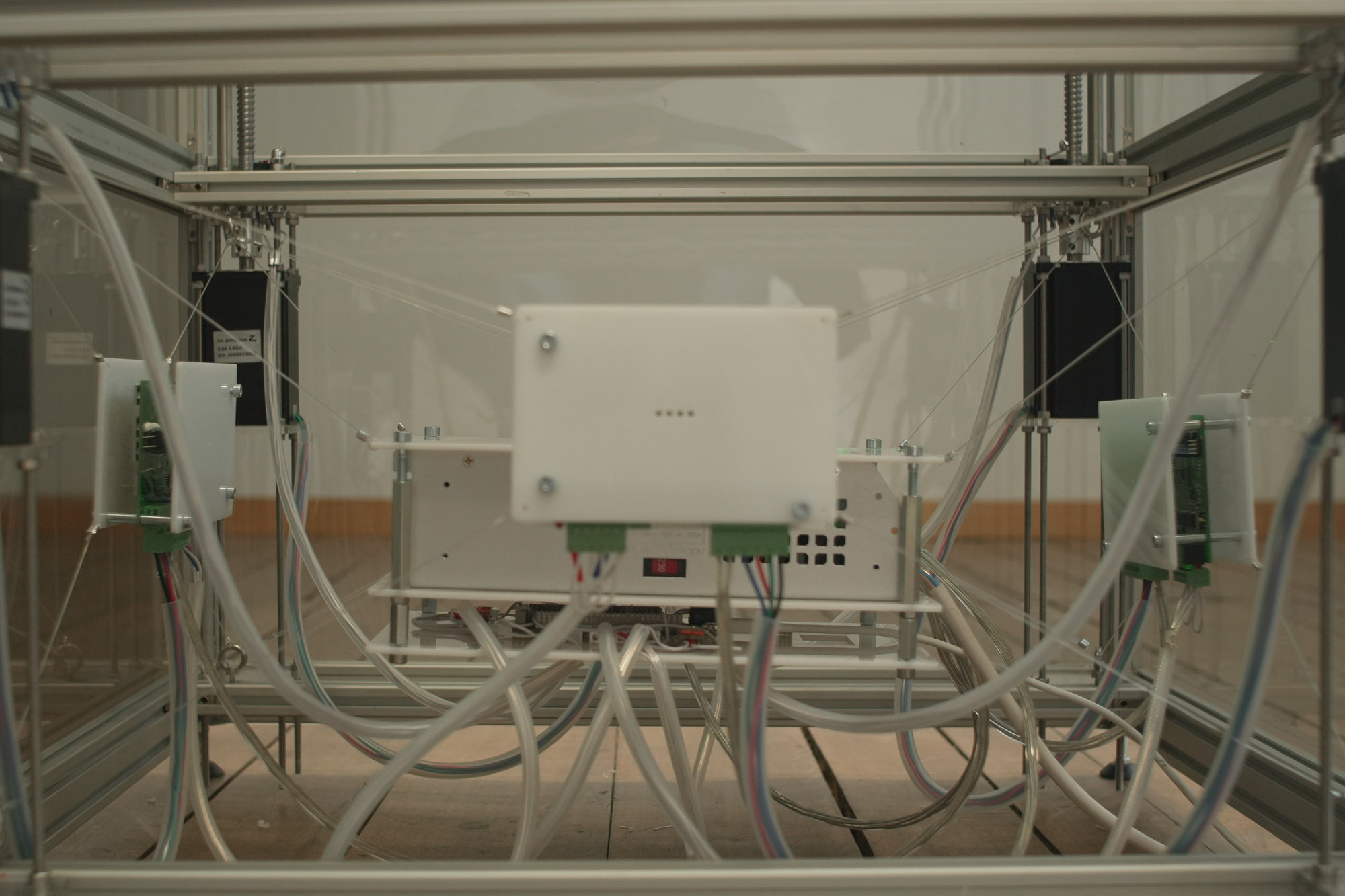
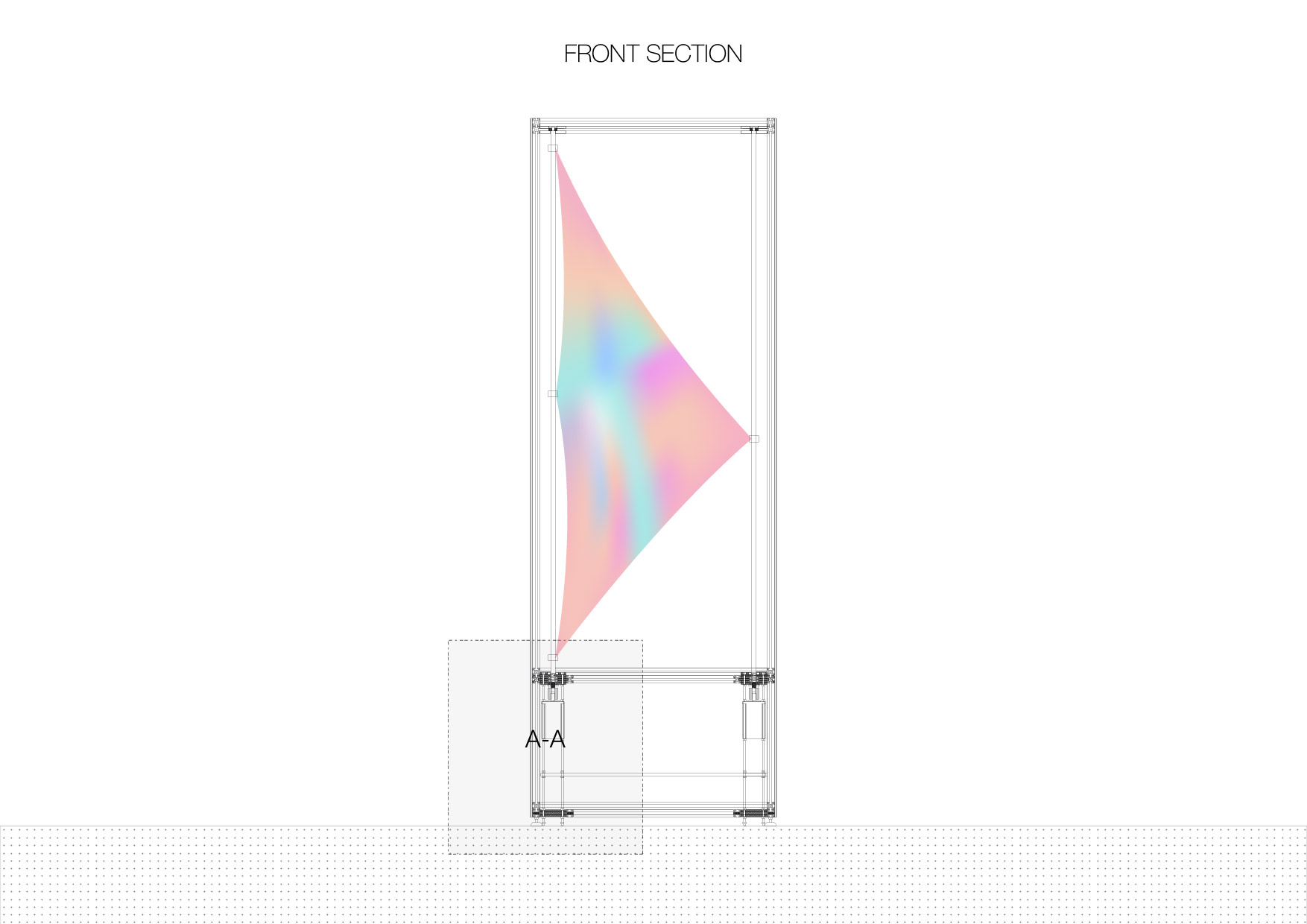
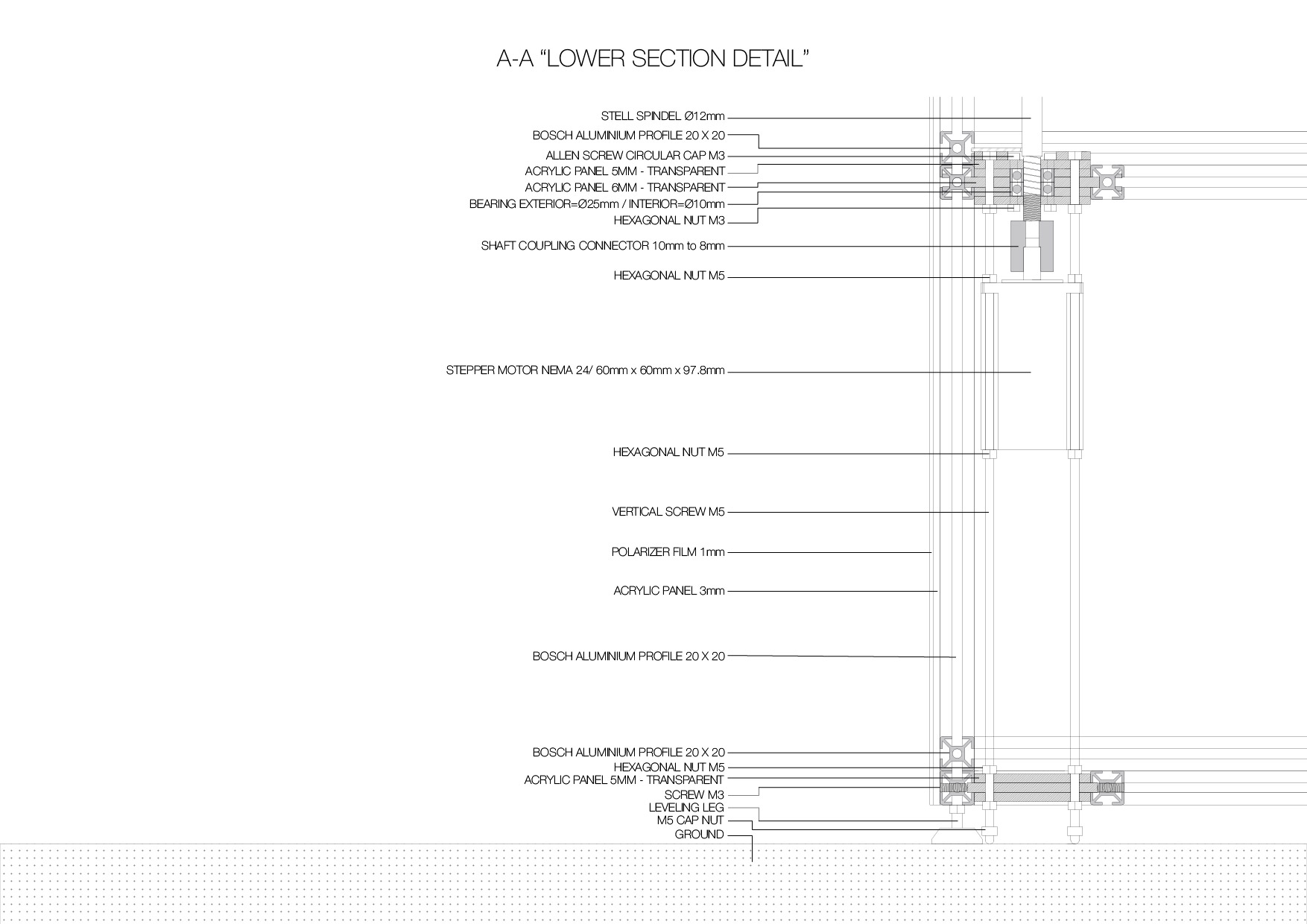
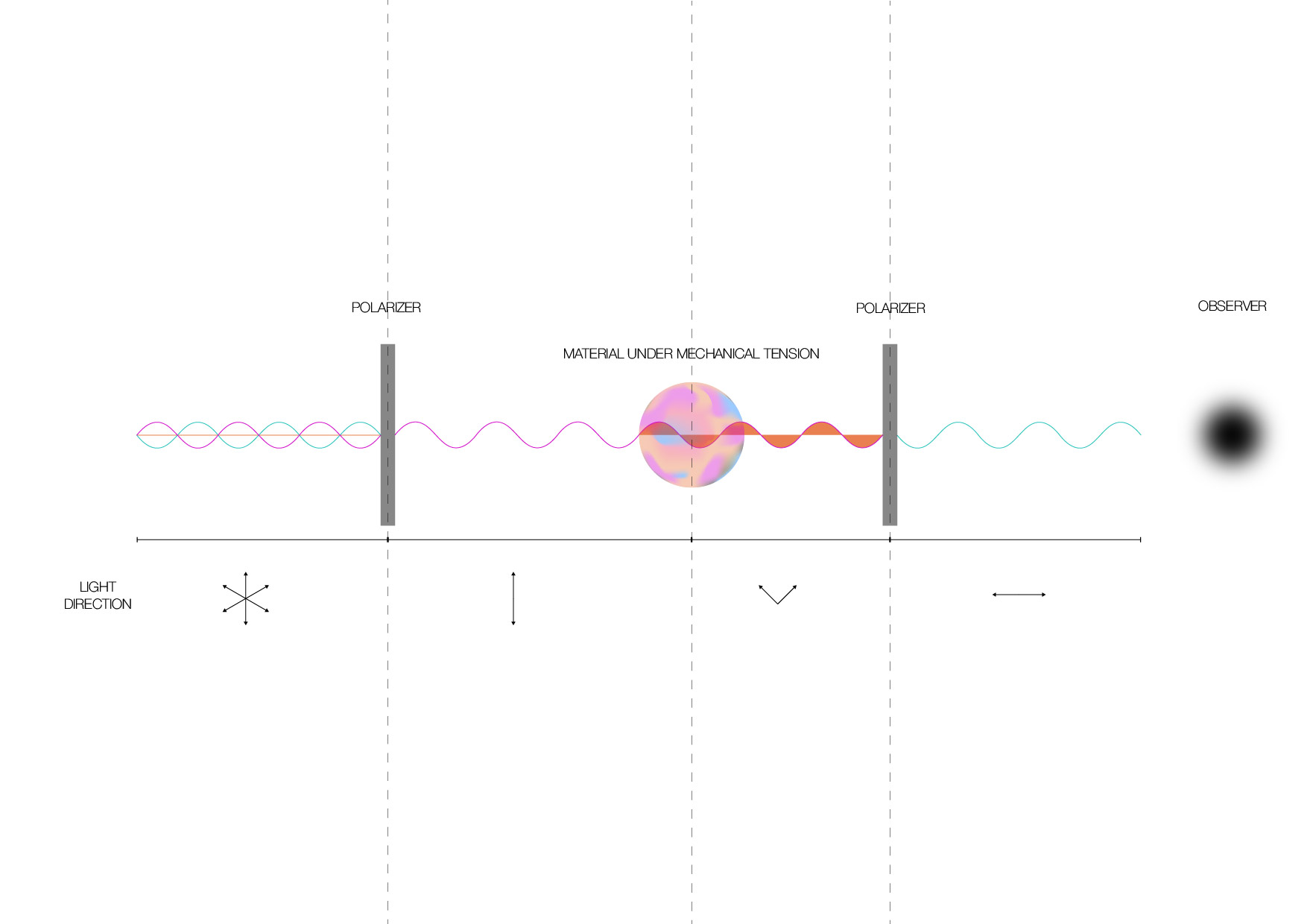
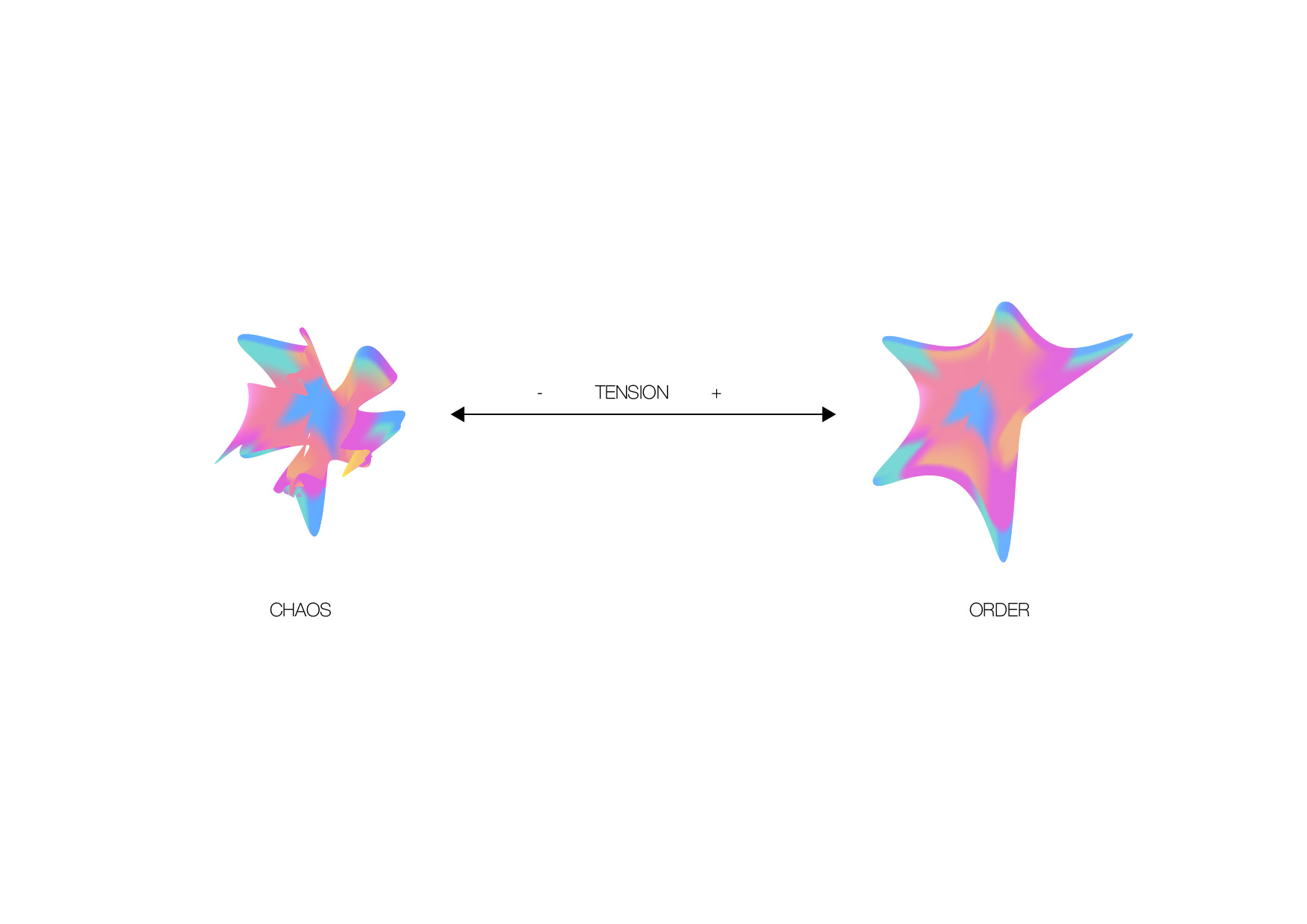
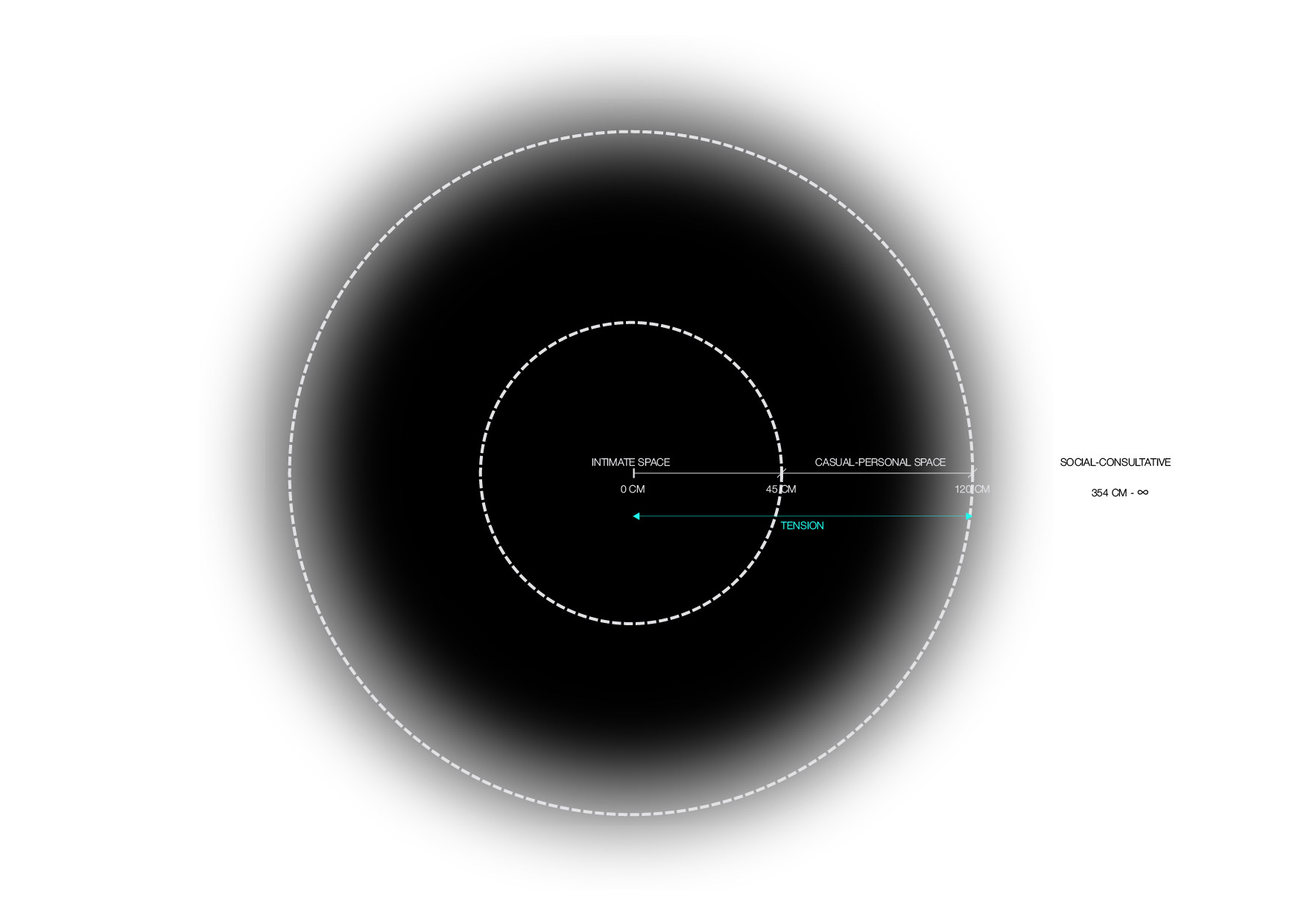
"000" is a video art and kinetic machine developed from the redesign of a CRT monitor, reconfigured as a contemporary optical device. At its core lies a custom acrylic lens with ripple geometry, conceived as a unique morphology for the work. This lens distorts the visuals, transforming the screen into a luminous field of interference and perception. The piece seeks to prolong fleeting perceptual moments—those ephemeral instants that usually vanish in seconds—by suspending them in an extended temporal frame through the static yet dynamic movement proposed by the lens.
The visual content emerges from a hybrid process combining digital and analog techniques. Starting from digital imagery, the visuals were processed through chains of analog mixers, feedback loops, and synthesizers, before being displayed on a CRT monitor. The re-recorded output was transferred to a Raspberry Pi and integrated into 000. This layered trajectory digital to analog, screen to lens—creates a hybrid materiality where the image becomes unstable, reshaped as it passes through successive systems of translation.
The work also engages with the notion of the “black box,” a system in which inputs and outputs are perceivable while the inner processes remain opaque. This trajectory from digital generation to analog feedback loops, through the CRT screen and into 000 renders the image as a black box in motion. Each translation transforms the signal in ways that are partly comprehensible yet fundamentally elusive. By exposing these passages, the piece opens the black box of image-making—not to resolve it, but to render its opacity visible, turning incomprehensible processes into perceptual experience.
The interaction between distorted visuals and ripple morphology generates luminous effects and optical illusions, challenging perception and dissolving boundaries between the static and the dynamic. As light shifts and transforms, new perspectives emerge, inviting exploration of duality. By reanimating a discarded medium through a new material language, 000 reflects on the persistence of technology, the fragility of perception, and the fleeting nature of images as they pass through bodies, lenses, and time.

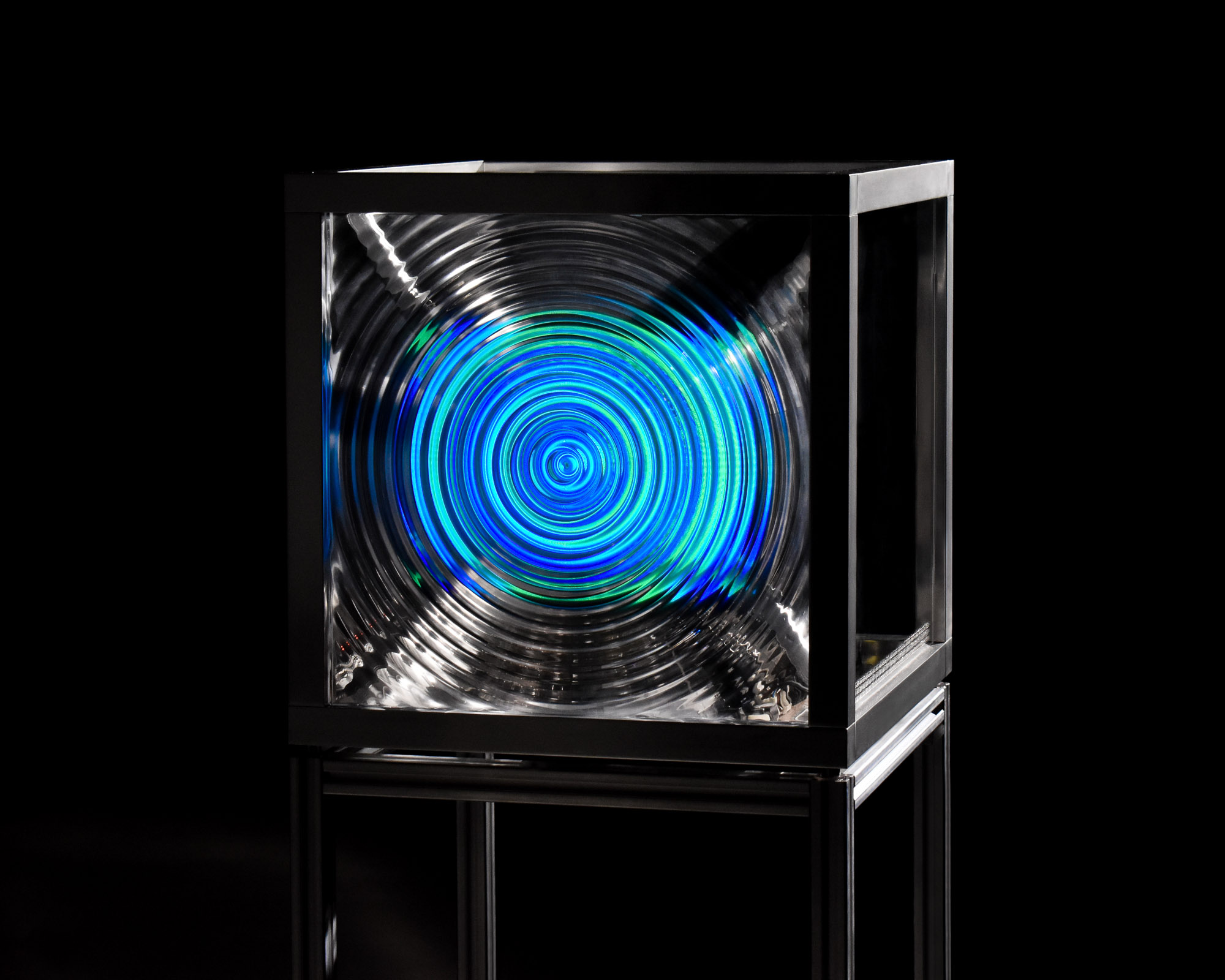
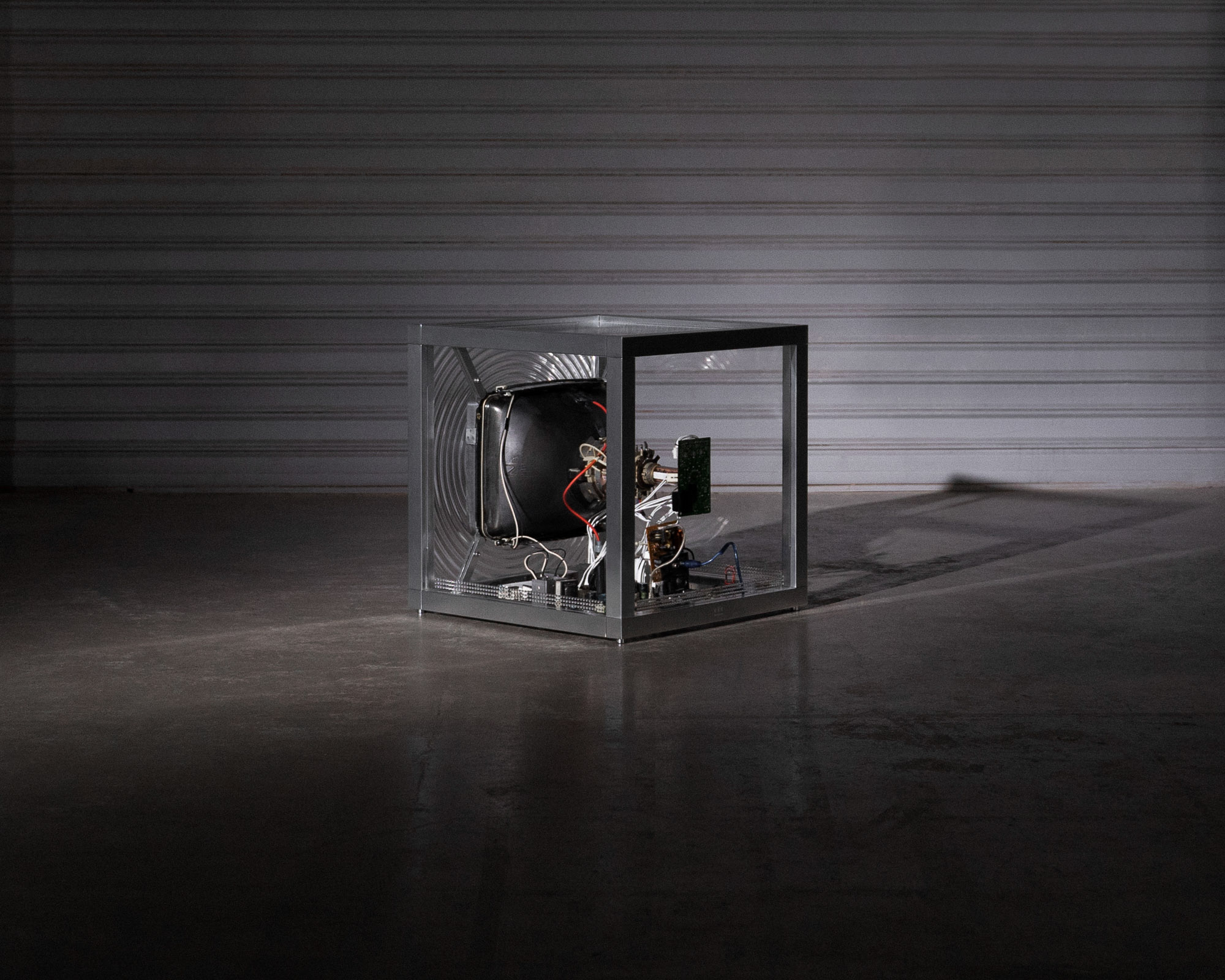
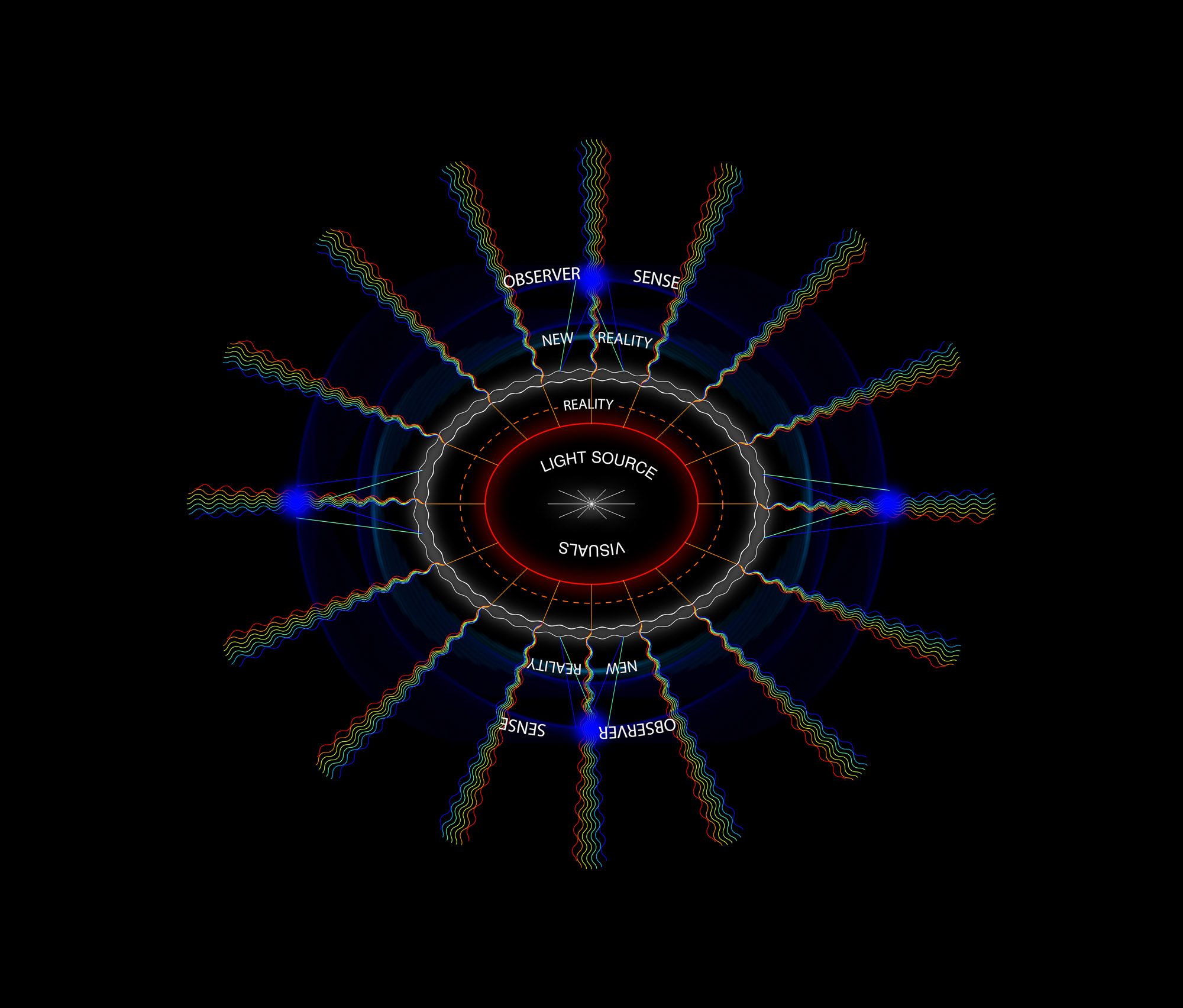
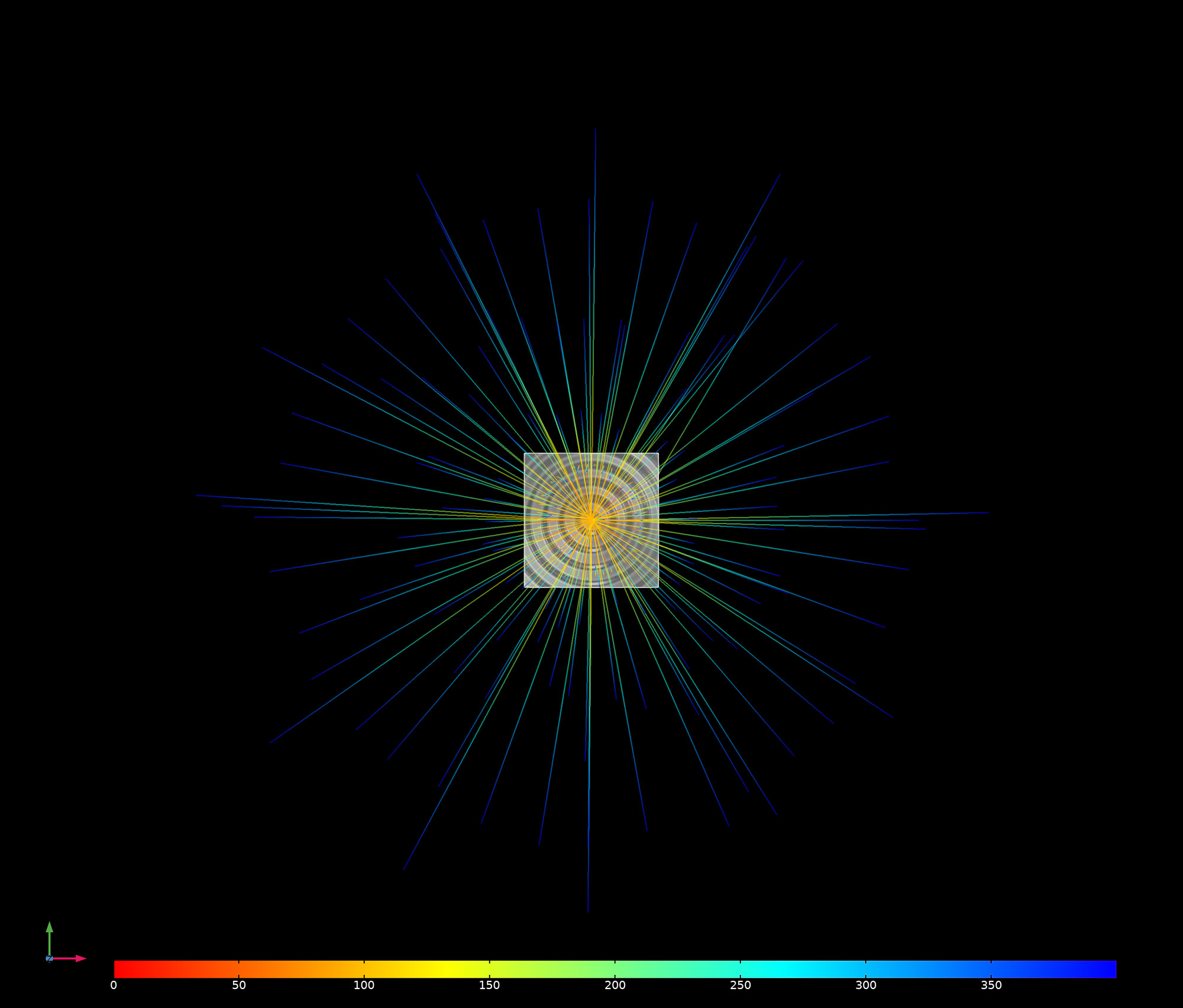
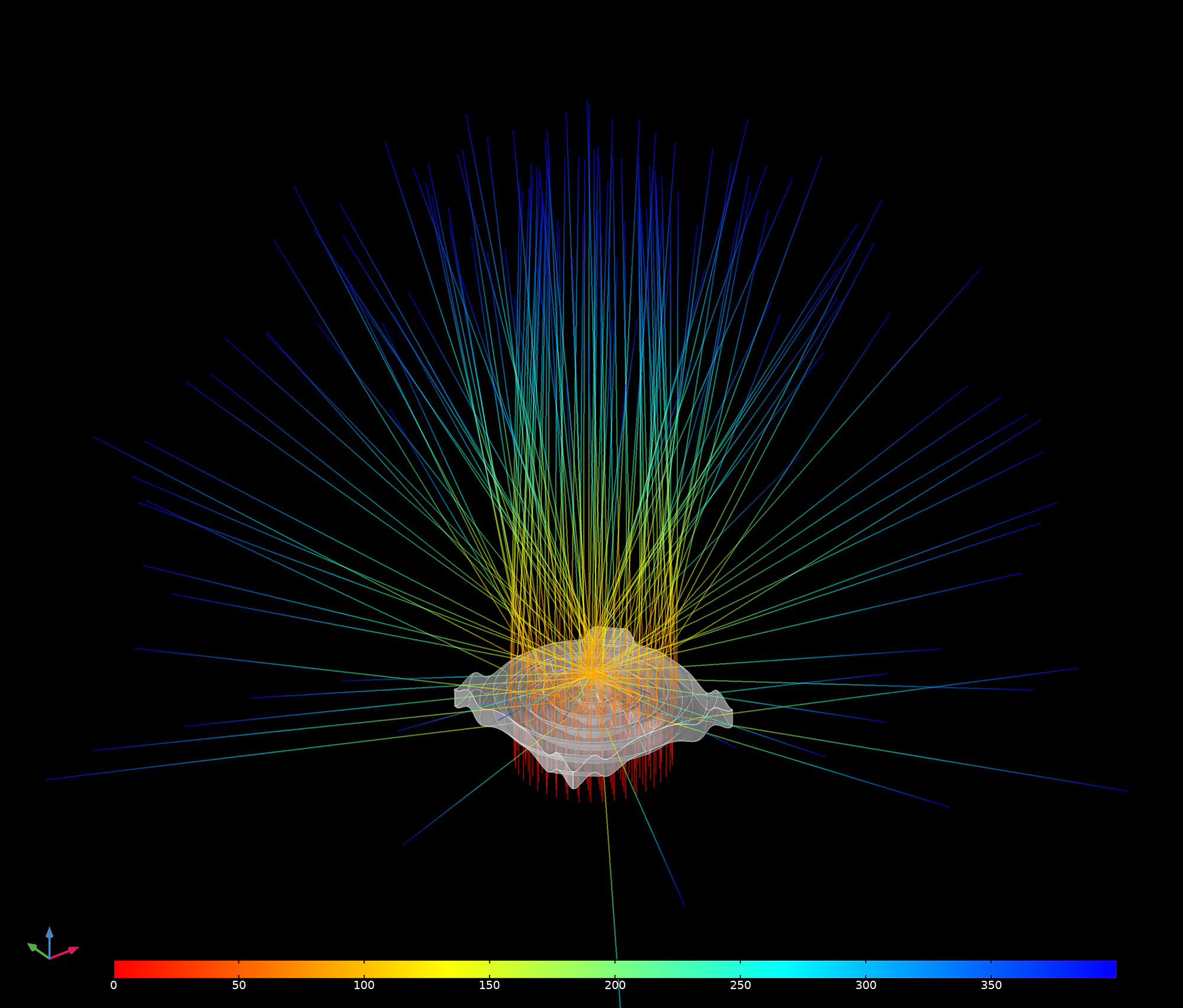
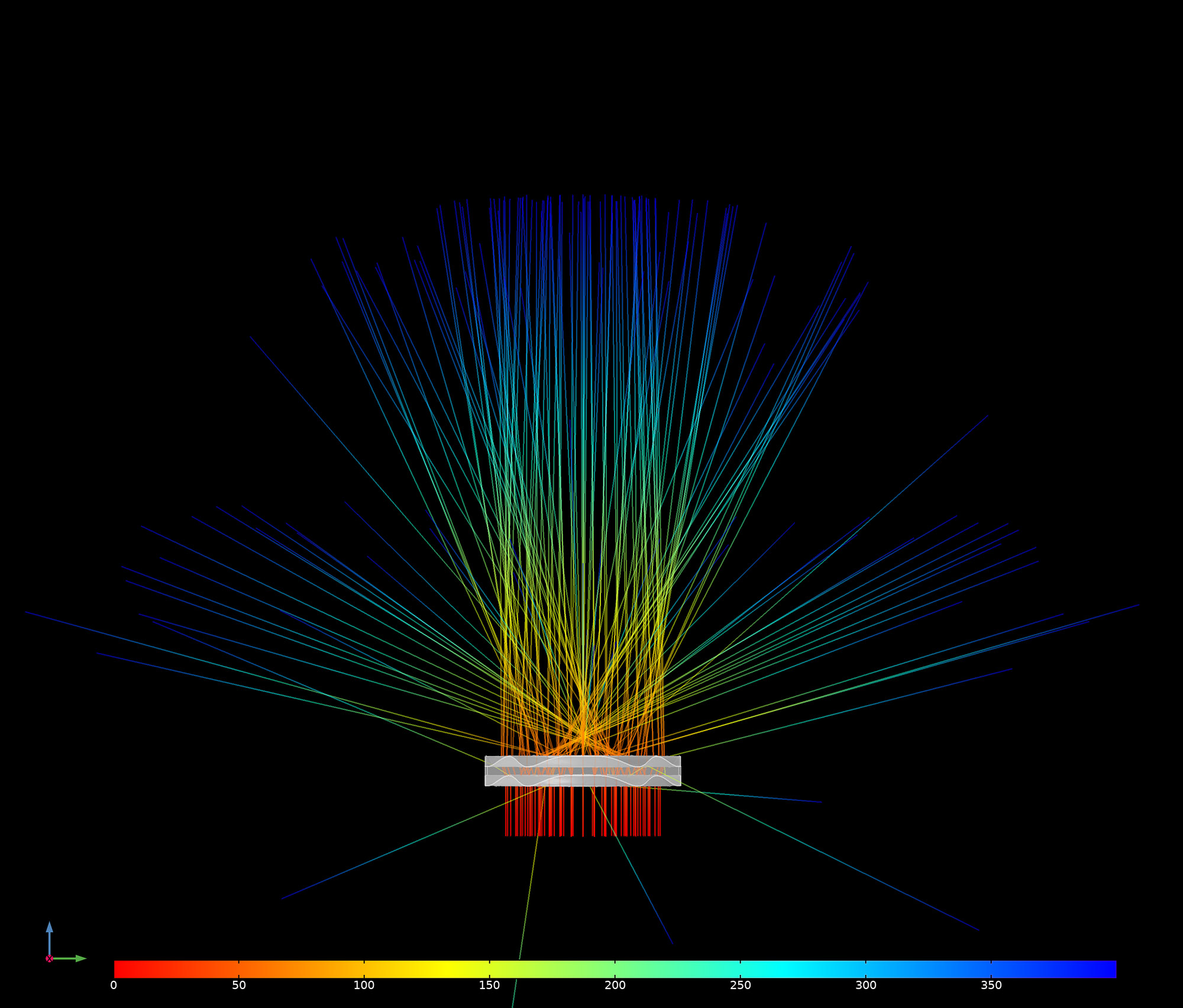
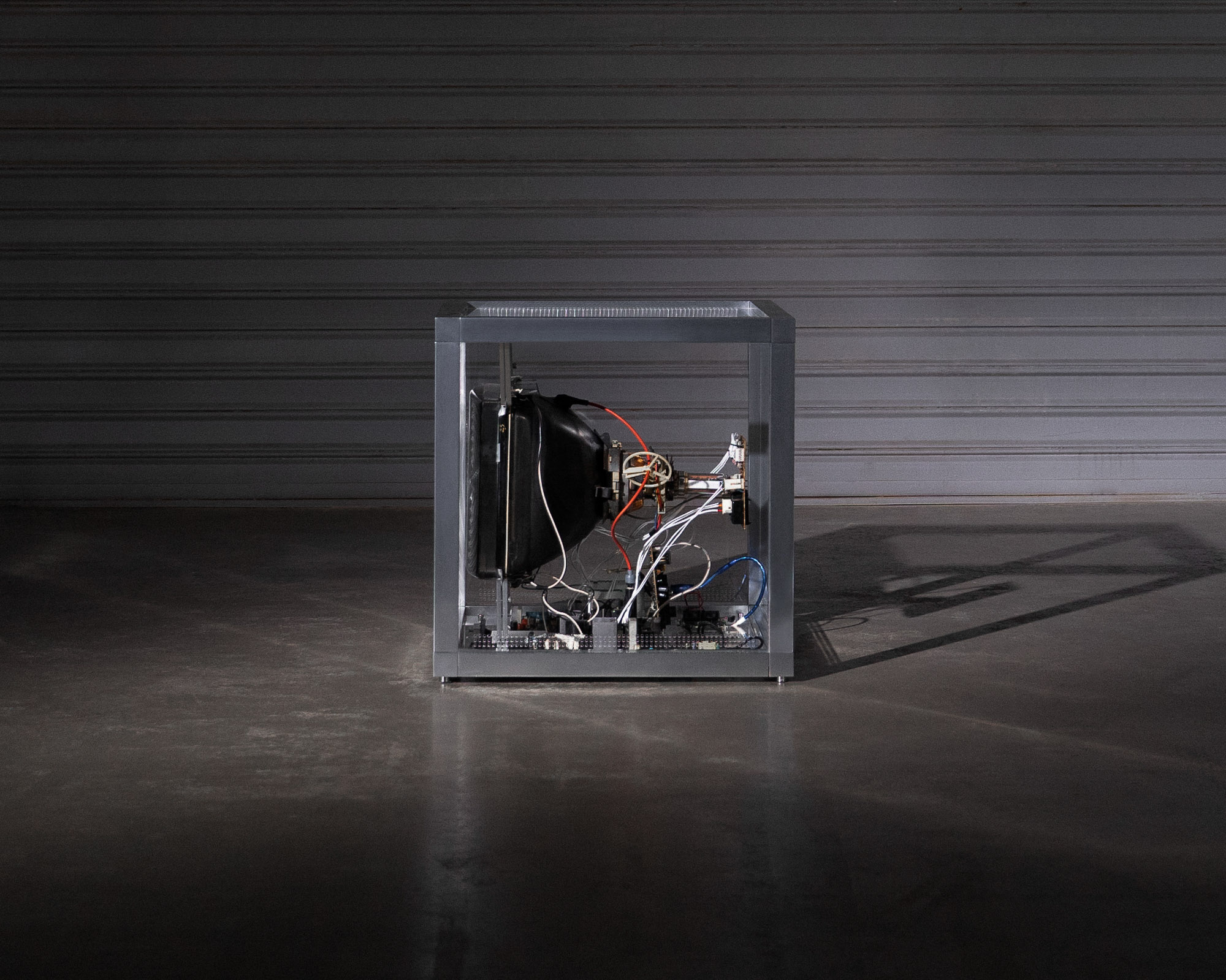
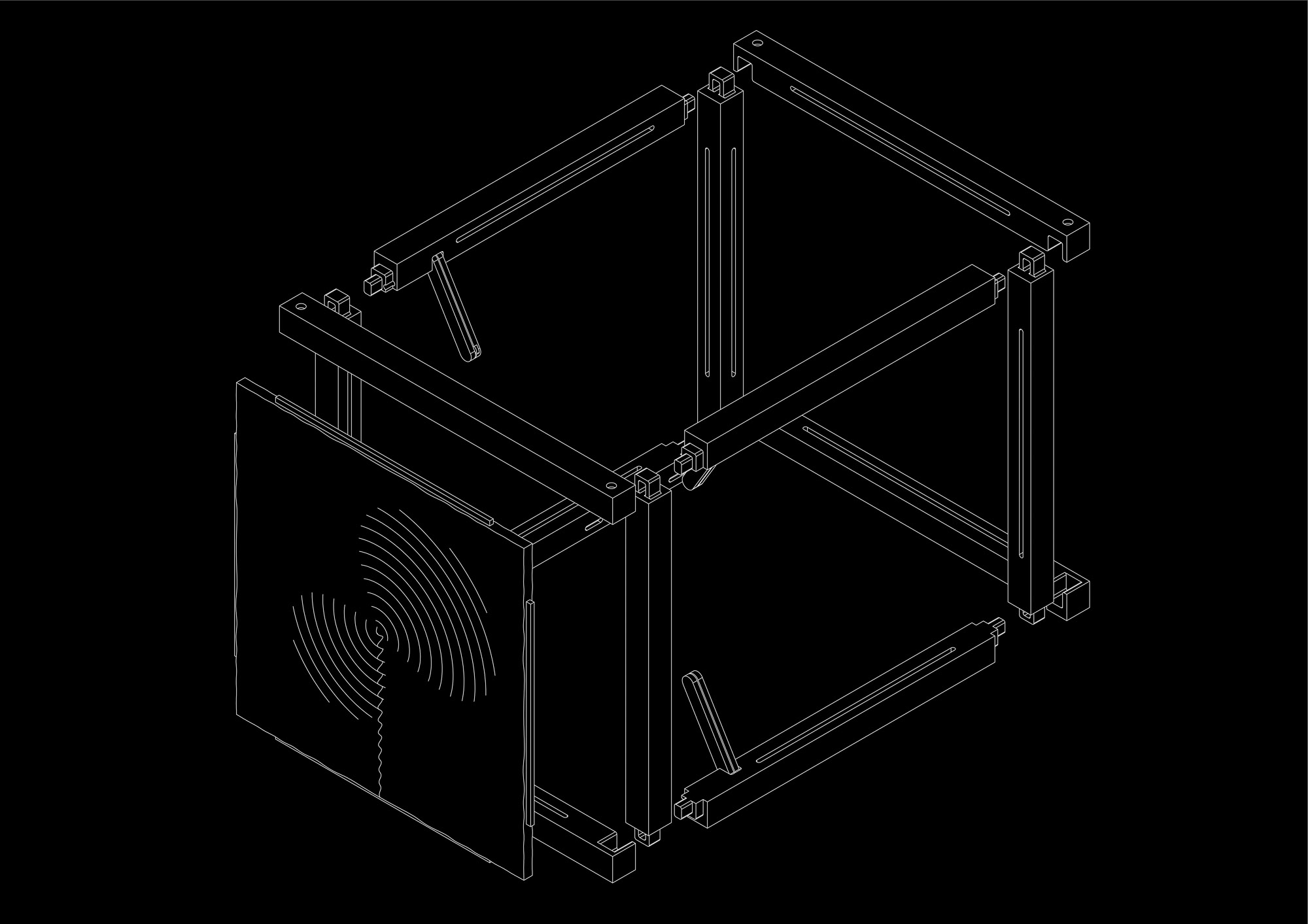
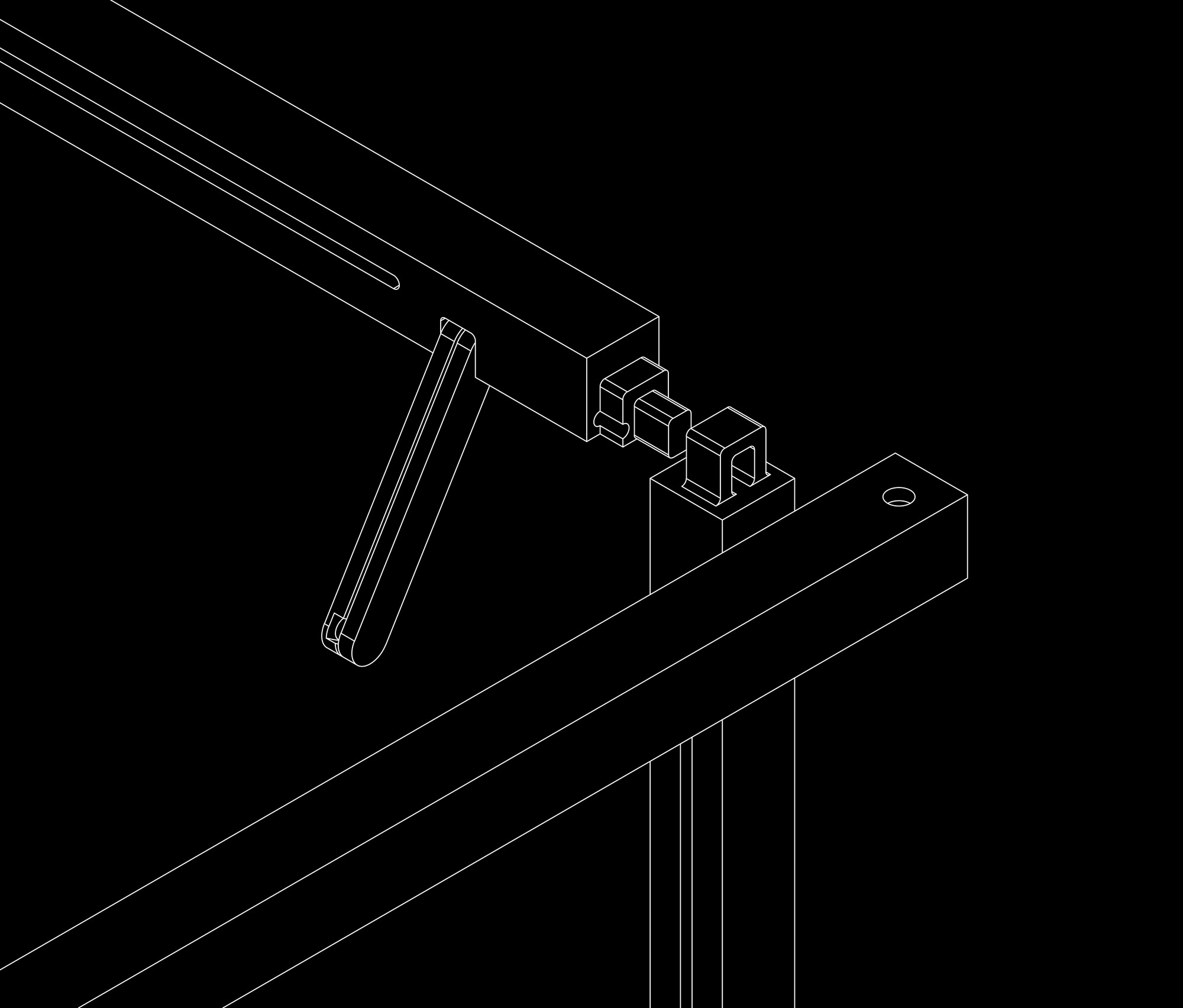
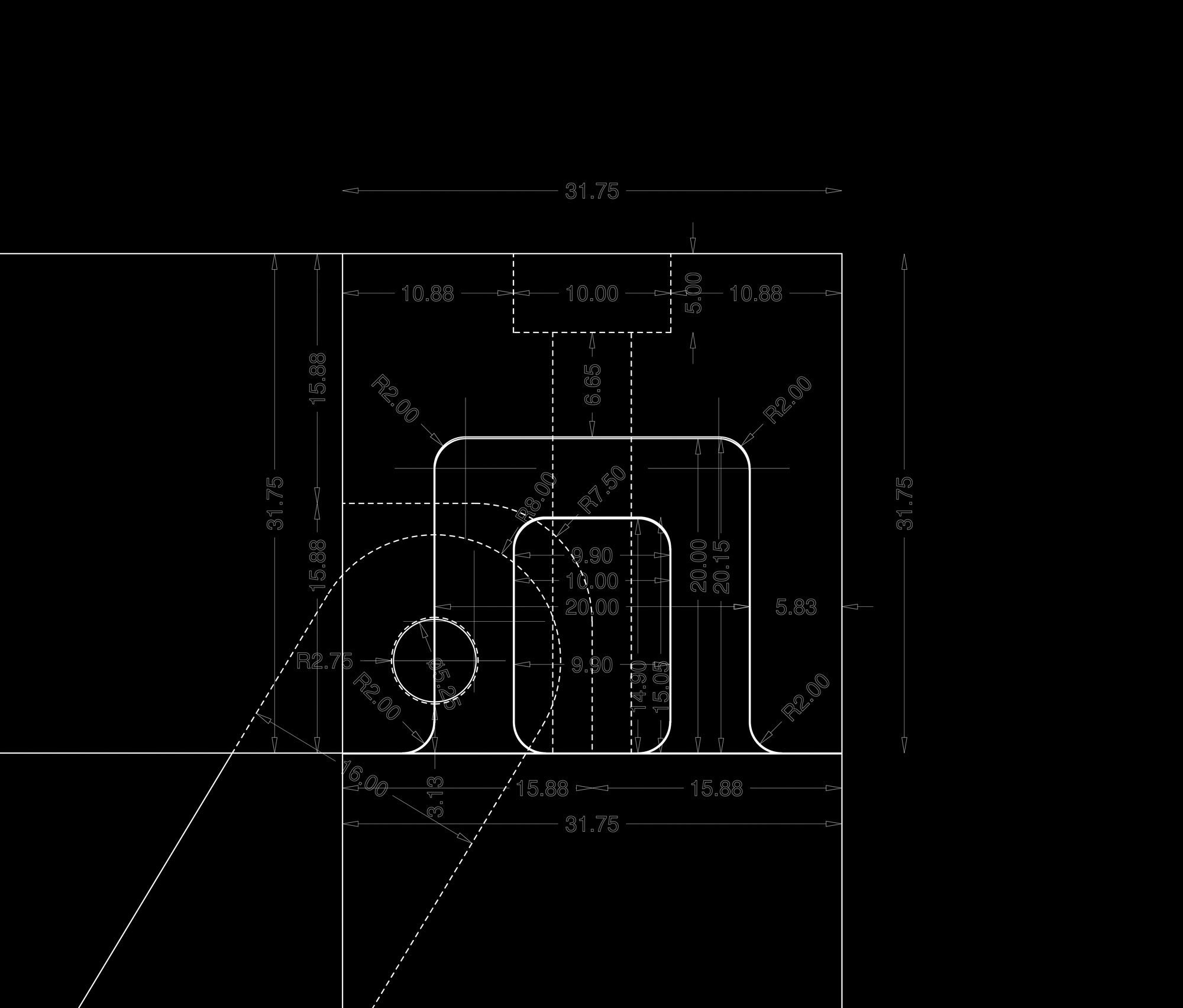
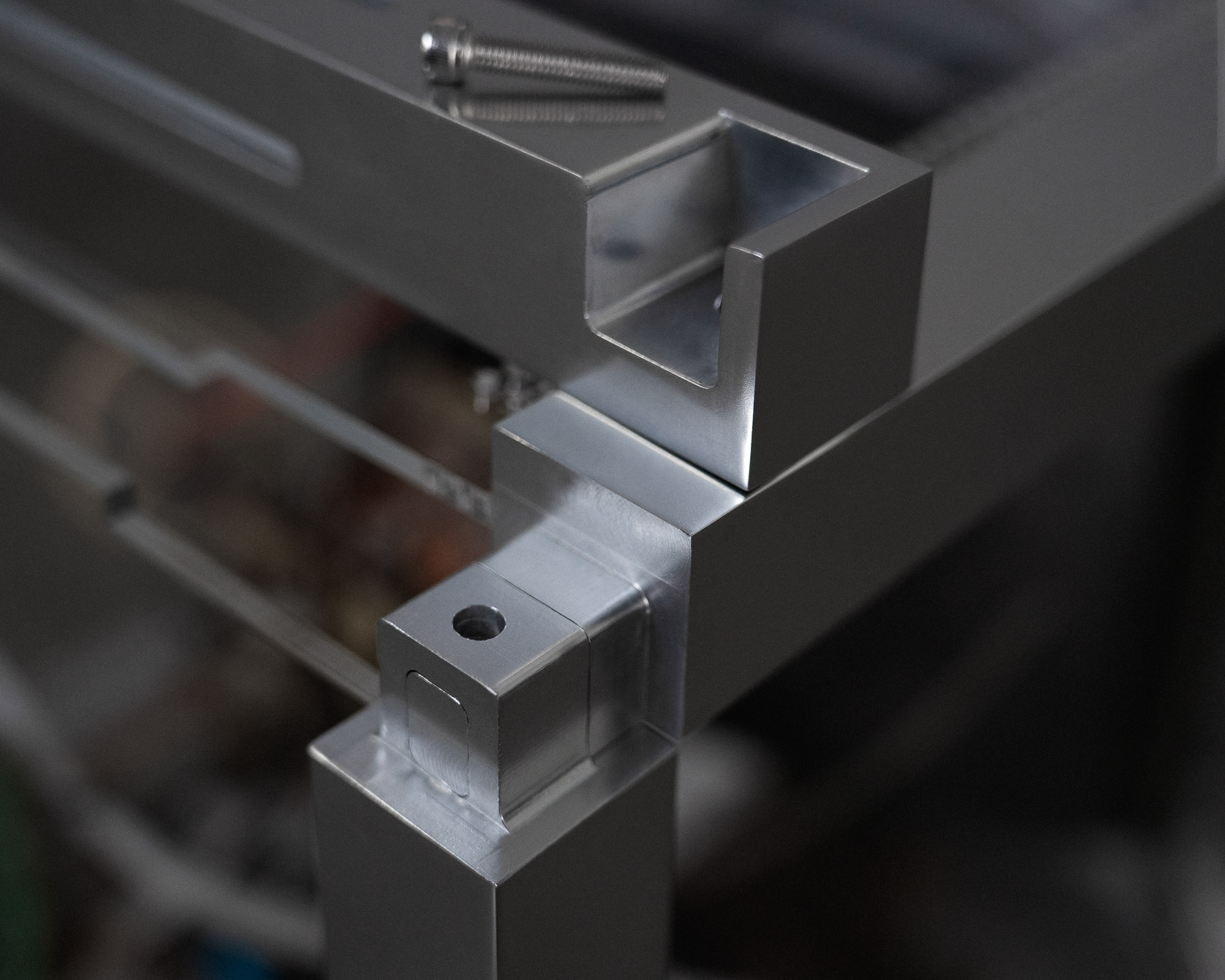
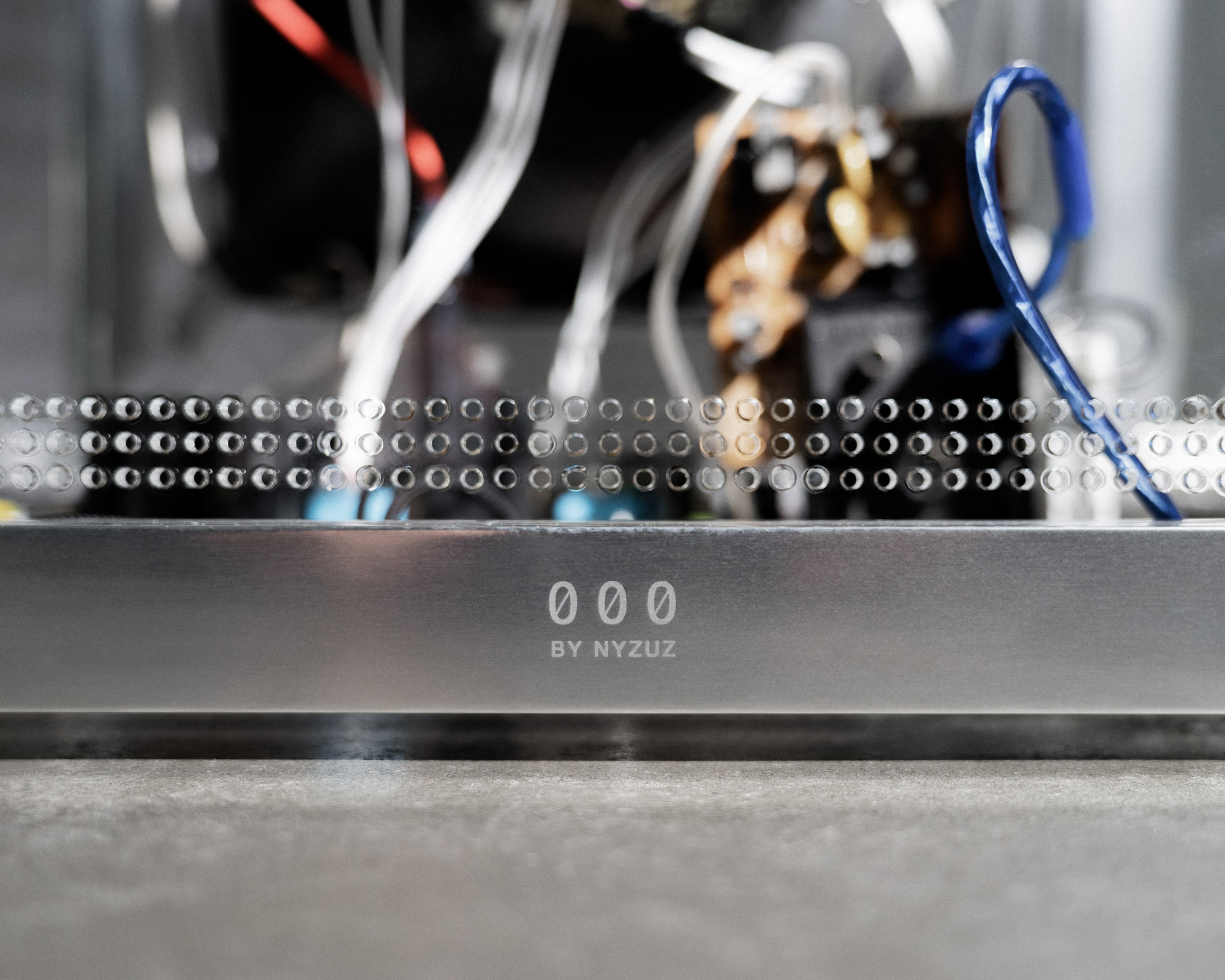
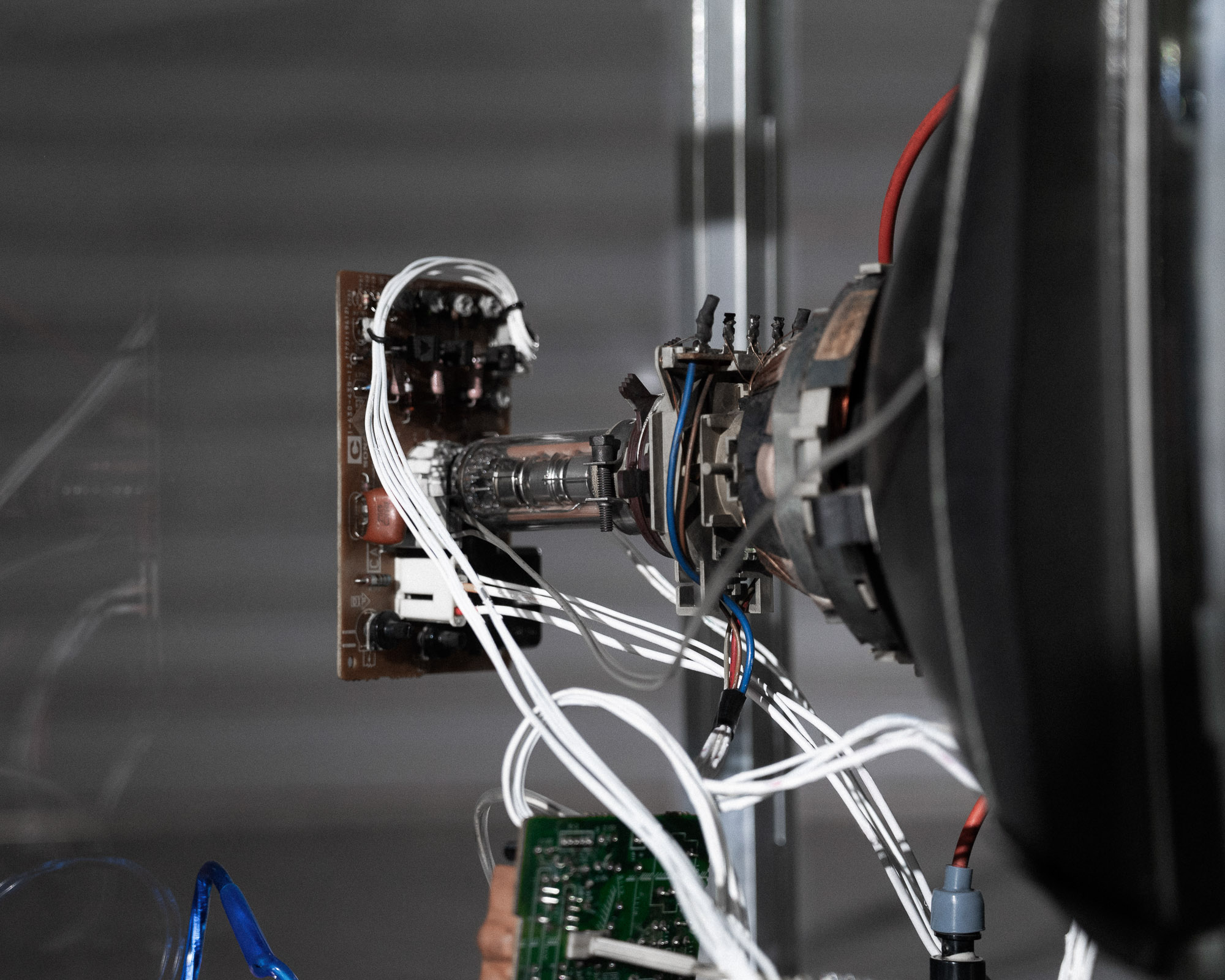
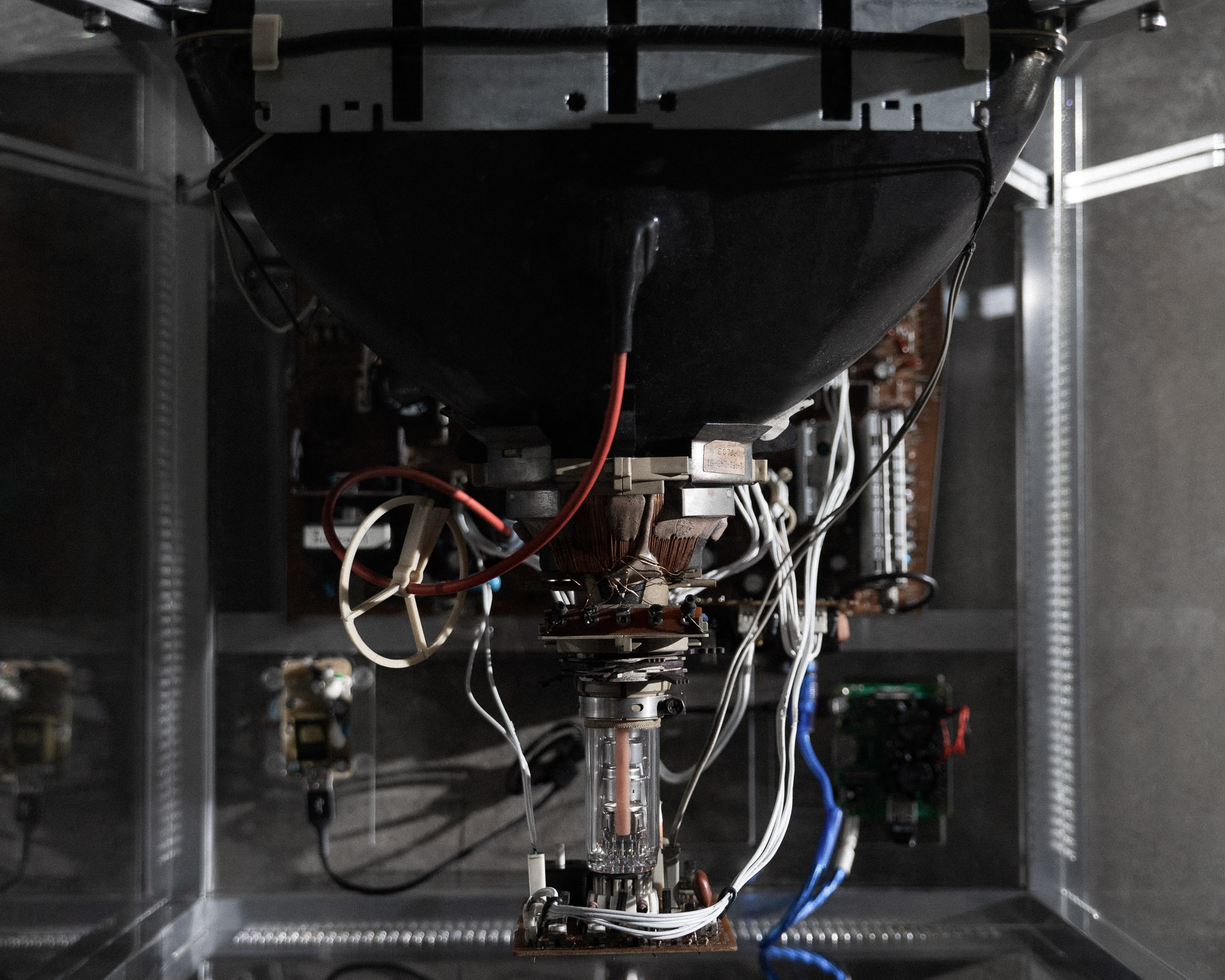
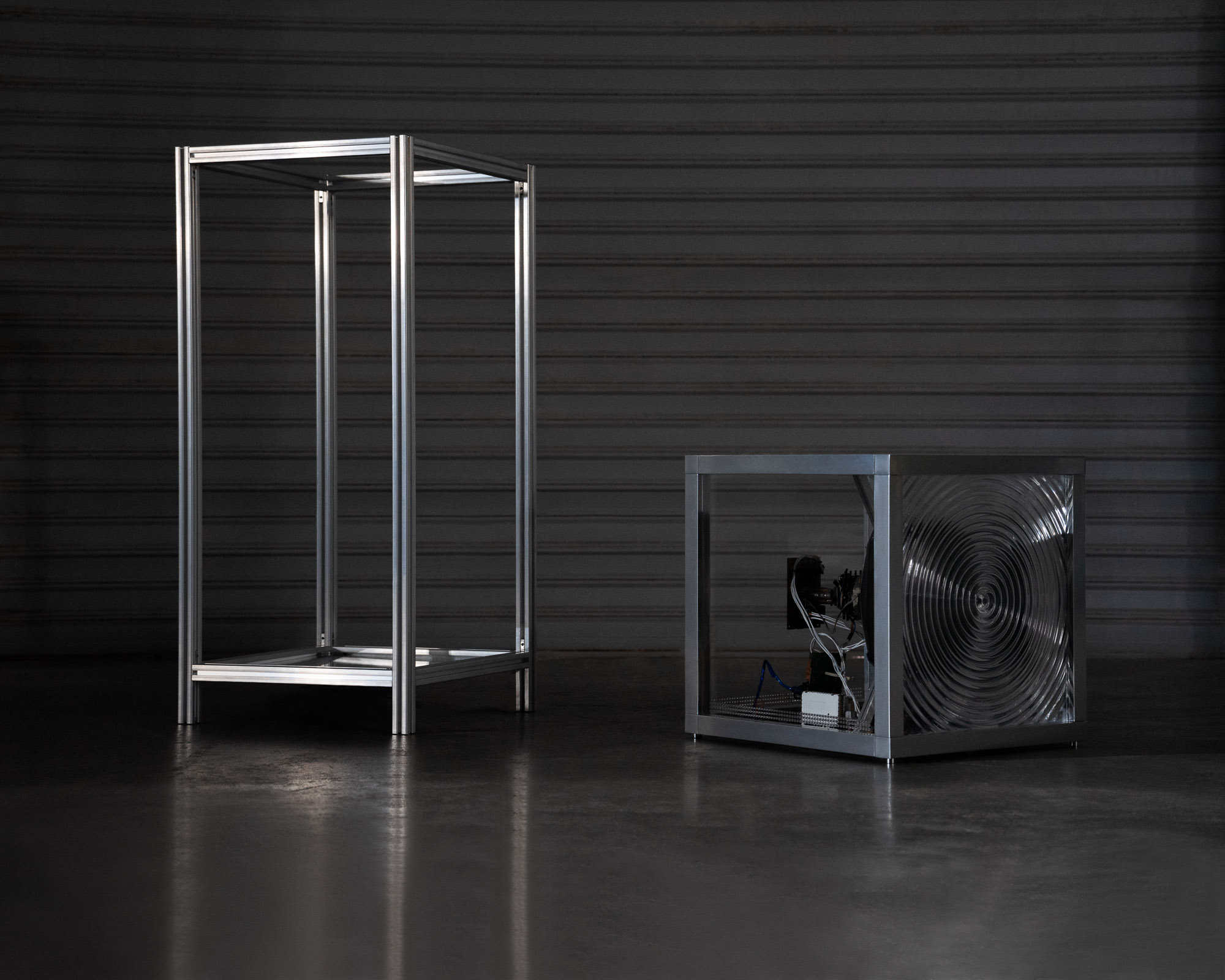
Flows of Entropy begins from an icosahedron, a geometric figure associated with stability, which is transformed into an organic morphology inspired by microscopic marine organisms. This shift from the geometric to the biological highlights the tension between abstract forms and structures found in nature.
Inside, a flexible container filled with water occupies the voids of the structure and acts as the active core of the piece. Water introduces a condition of instability: it is never static, always susceptible to minimal disturbances. A source of overhead light passes through this liquid body and projects constantly changing refraction patterns into the surrounding space.
The sculpture is suspended and responds directly to its environment. Air currents, spatial vibrations, or the movement of visitors alter the water, generating unrepeatable optical variations. The work is therefore not conceived as a fixed object but as an open system in which material and environmental conditions are interdependent.
The project is framed within a broader investigation of entropy understood as both a physical and perceptual process. The initial geometric order is altered by fluctuations that produce ephemeral optical configurations. The piece does not aim to represent entropy symbolically, but rather to make it visible as a sensible dynamic in space, where disorder is not destruction but a condition for variation.
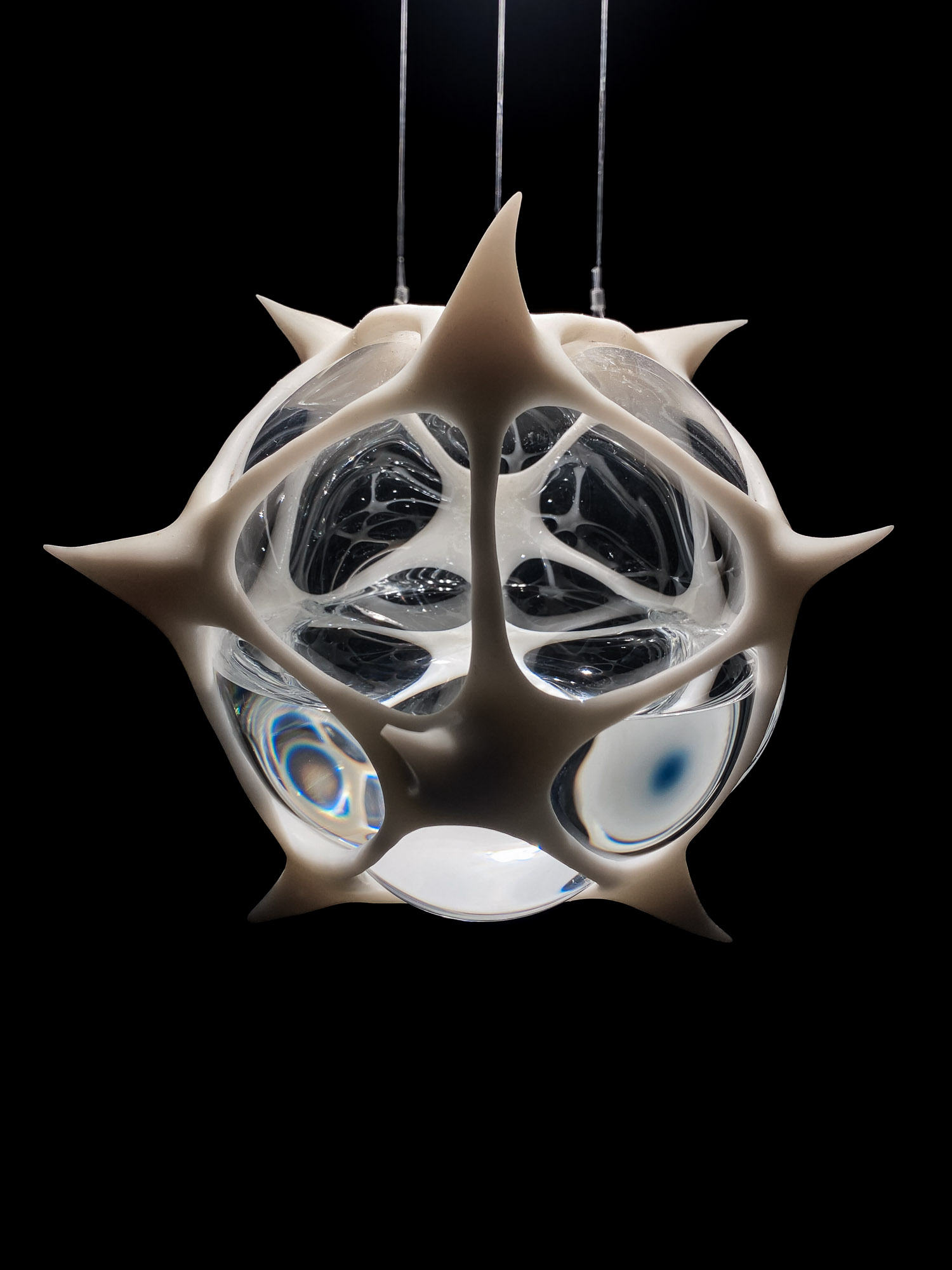
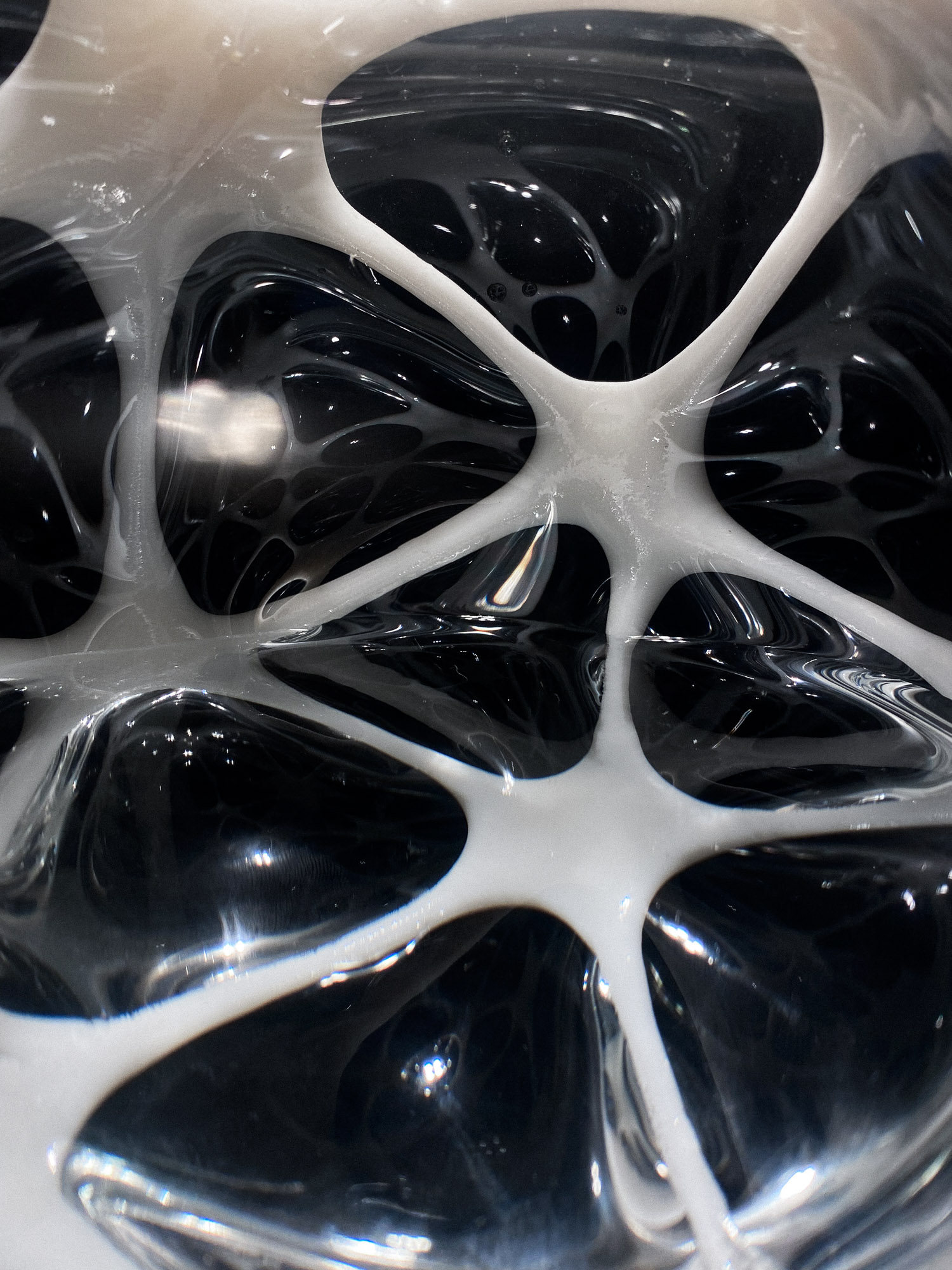
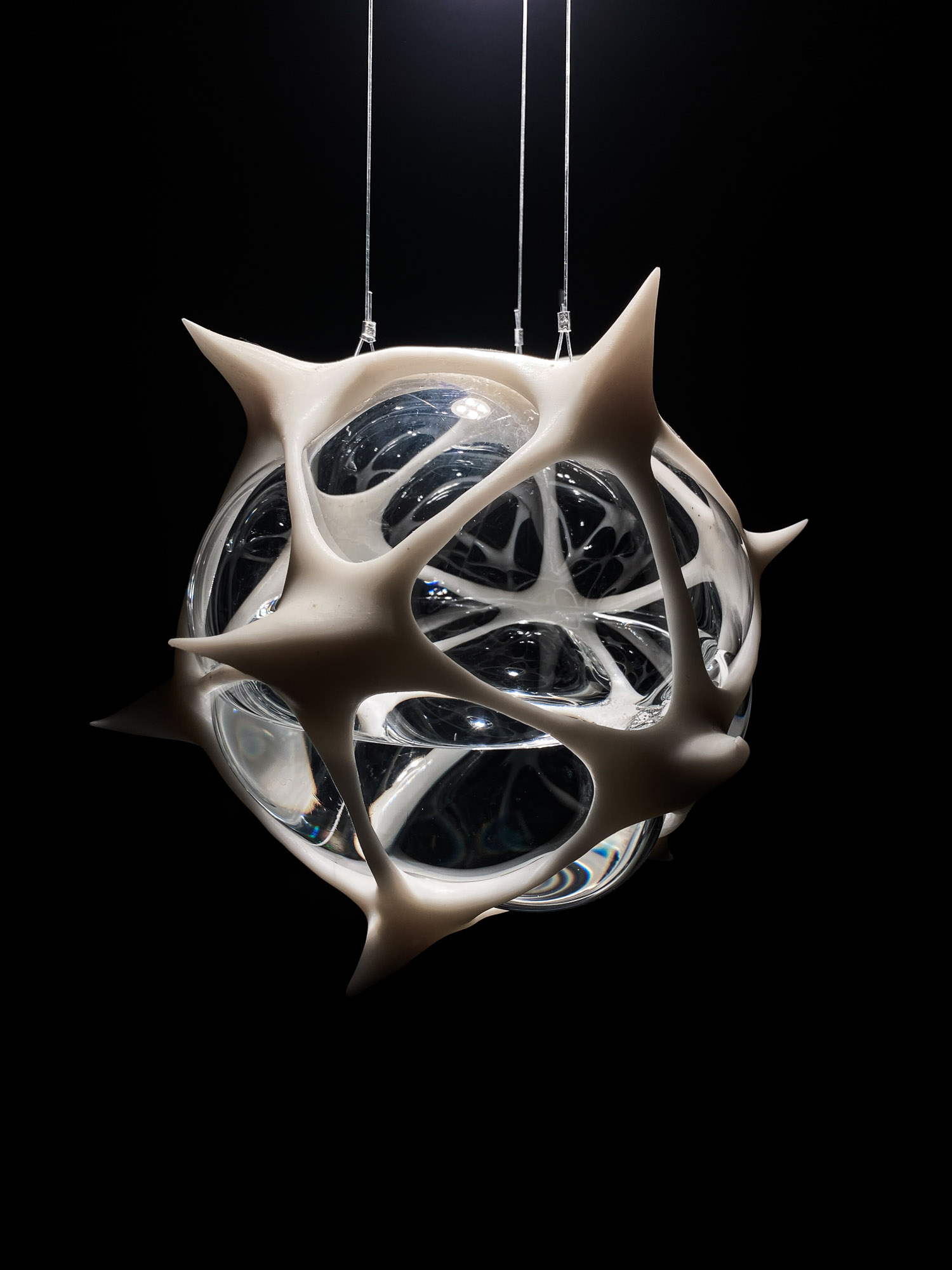
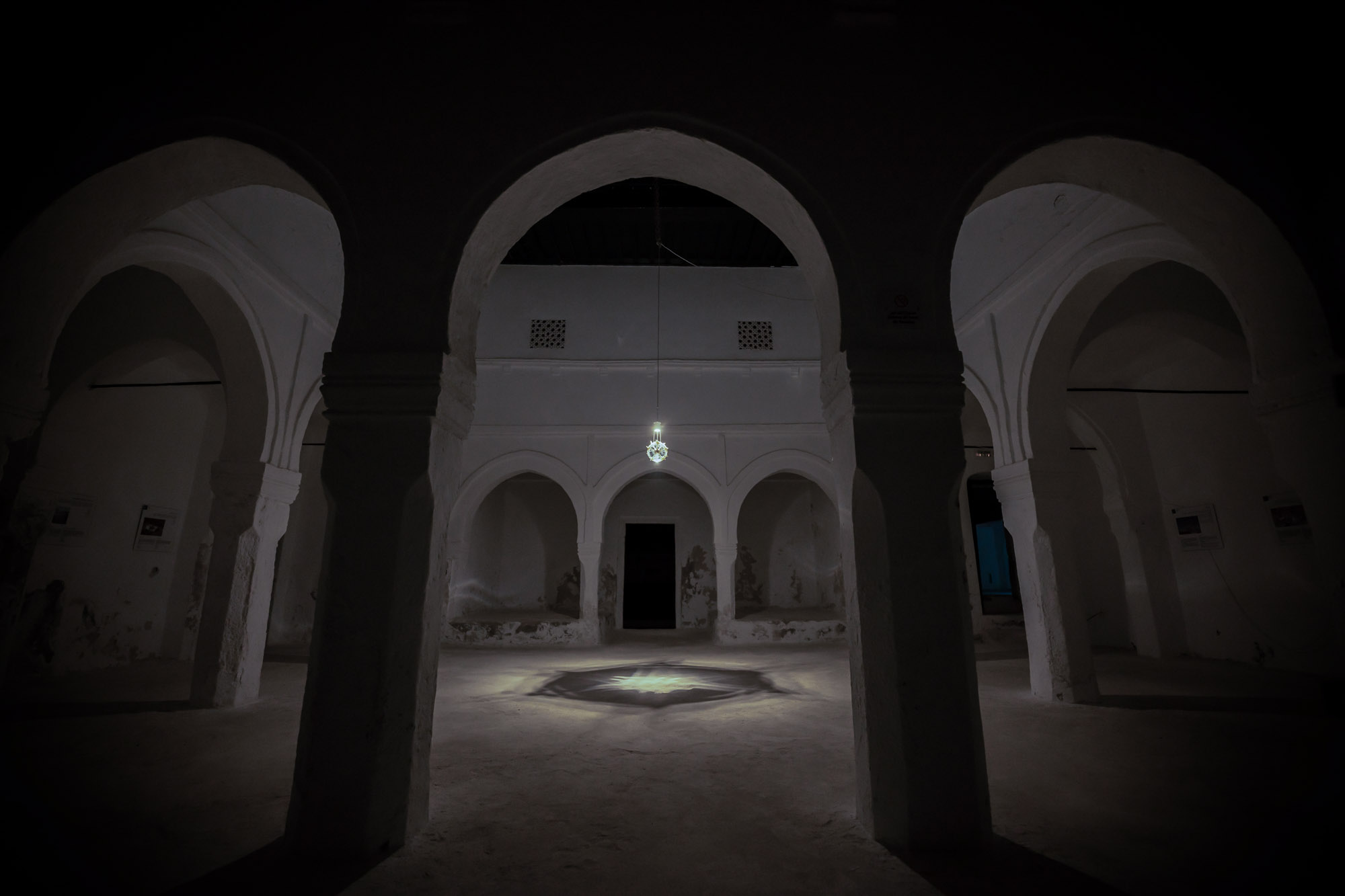
Wetmesh I is an interactive installation composed of a TPU membrane suspended from the ceiling by a system of tension cables. Inside, it contains 50 liters of water that stretch the material into an organic form. The cables can be manipulated by those engaging with the work: each movement triggers vibrations in the water, which in turn displace the membrane and produce variations in the projected light.
The piece operates as a sensitive organism in which water, light, matter, and human bodies become entangled. The tension system not only transmits forces to the membrane but also establishes a non-verbal channel of communication between people interacting simultaneously. Oscillations propagate, transform, and return in a continuous exchange of shared vibrations.
Within the liquid body floats an inflatable object held by a geometric frame. Its role is not to mediate but to introduce interference: it acts as a parasitic element that makes noise and impurity visible, underscoring that all communication is permeated by fluctuations and instabilities.
The installation also acquires a “parasitic” dimension through its site. Presented in the FORUM of Lüdenscheid—an obsolete building—the work attaches itself to the existing architecture and activates it with new dynamics. On both spatial and material scales, Wetmesh I approaches the parasite not as a negative presence but as an agent that alters, interferes, and generates conditions for new modes of relation.
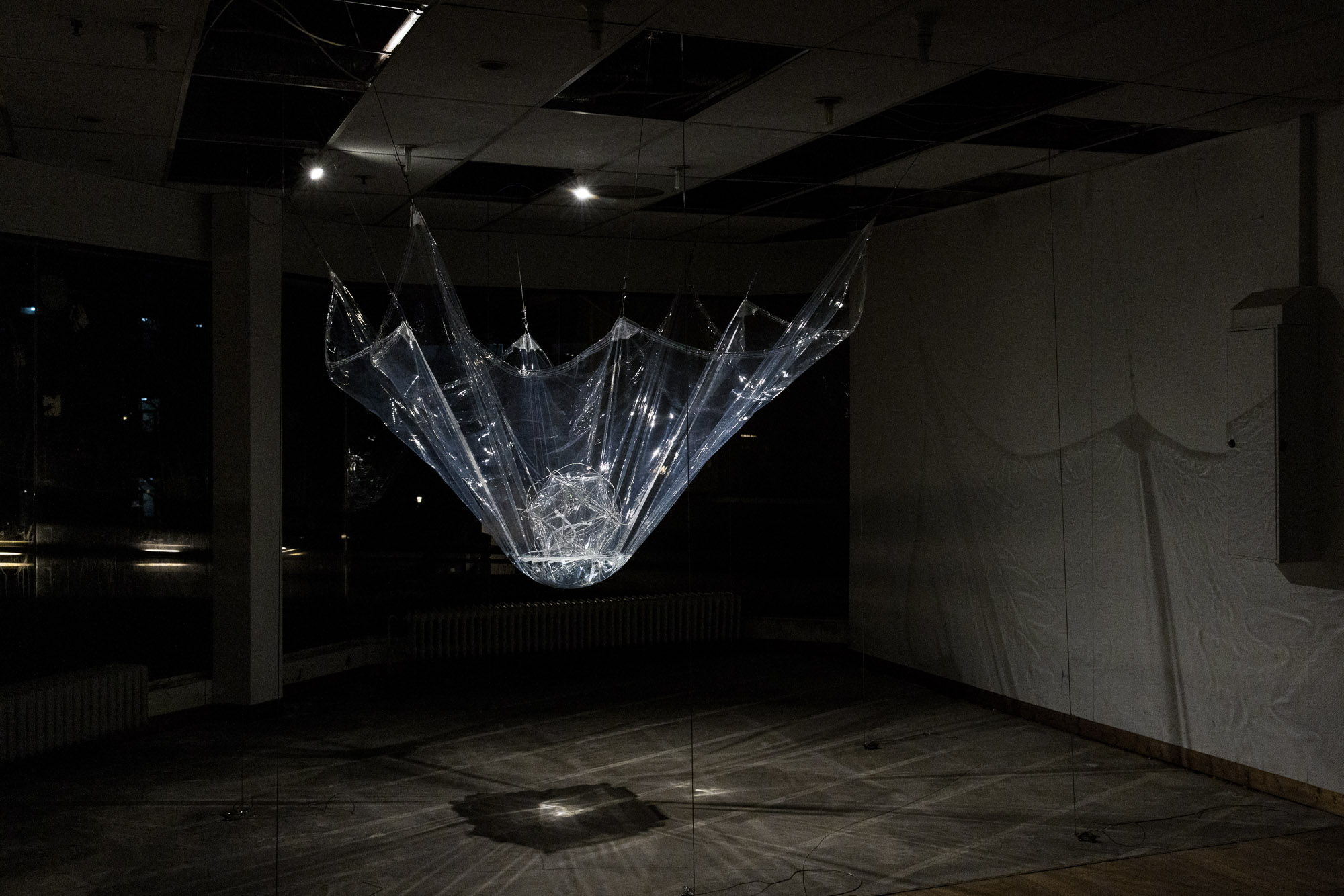
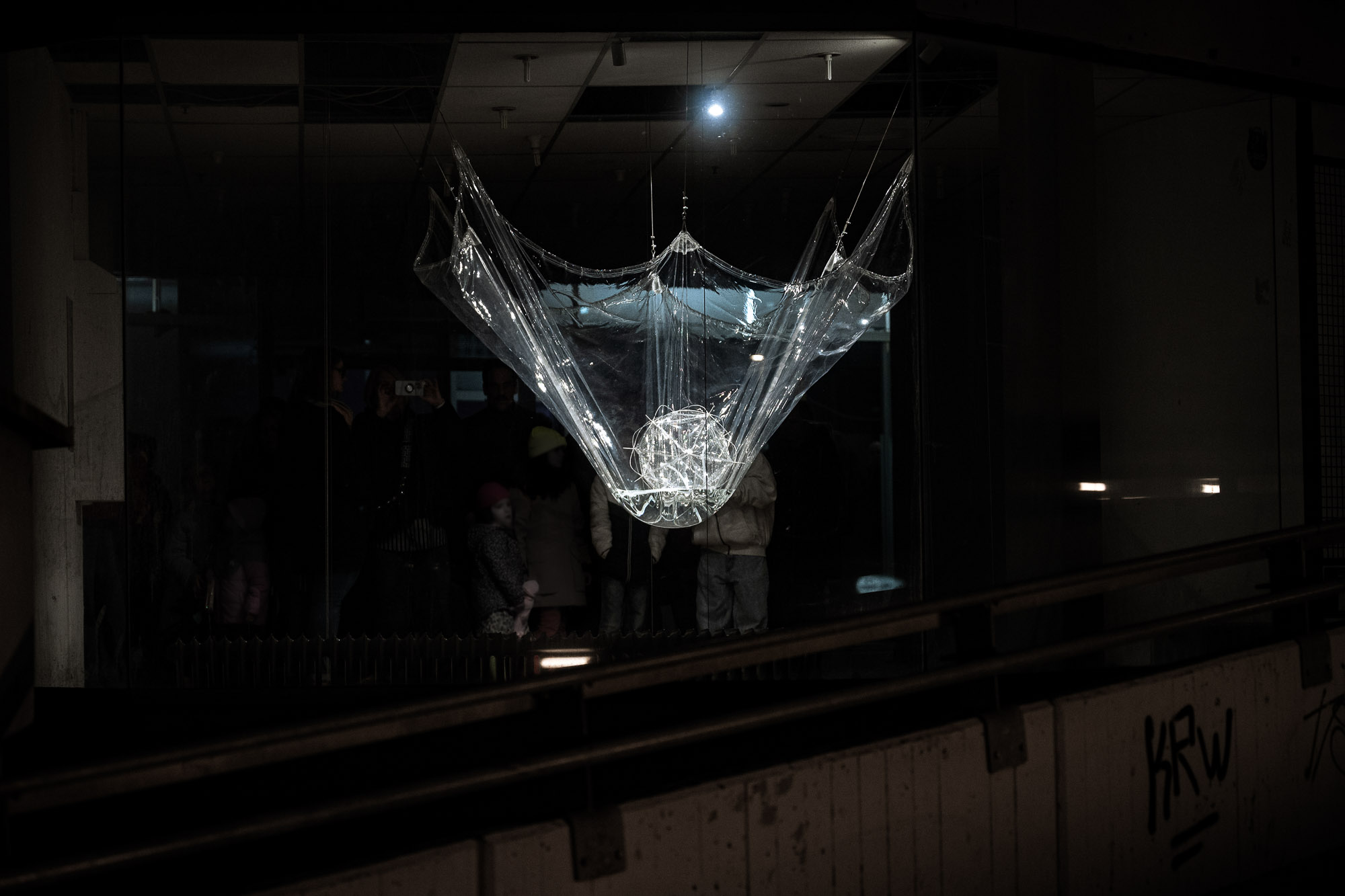
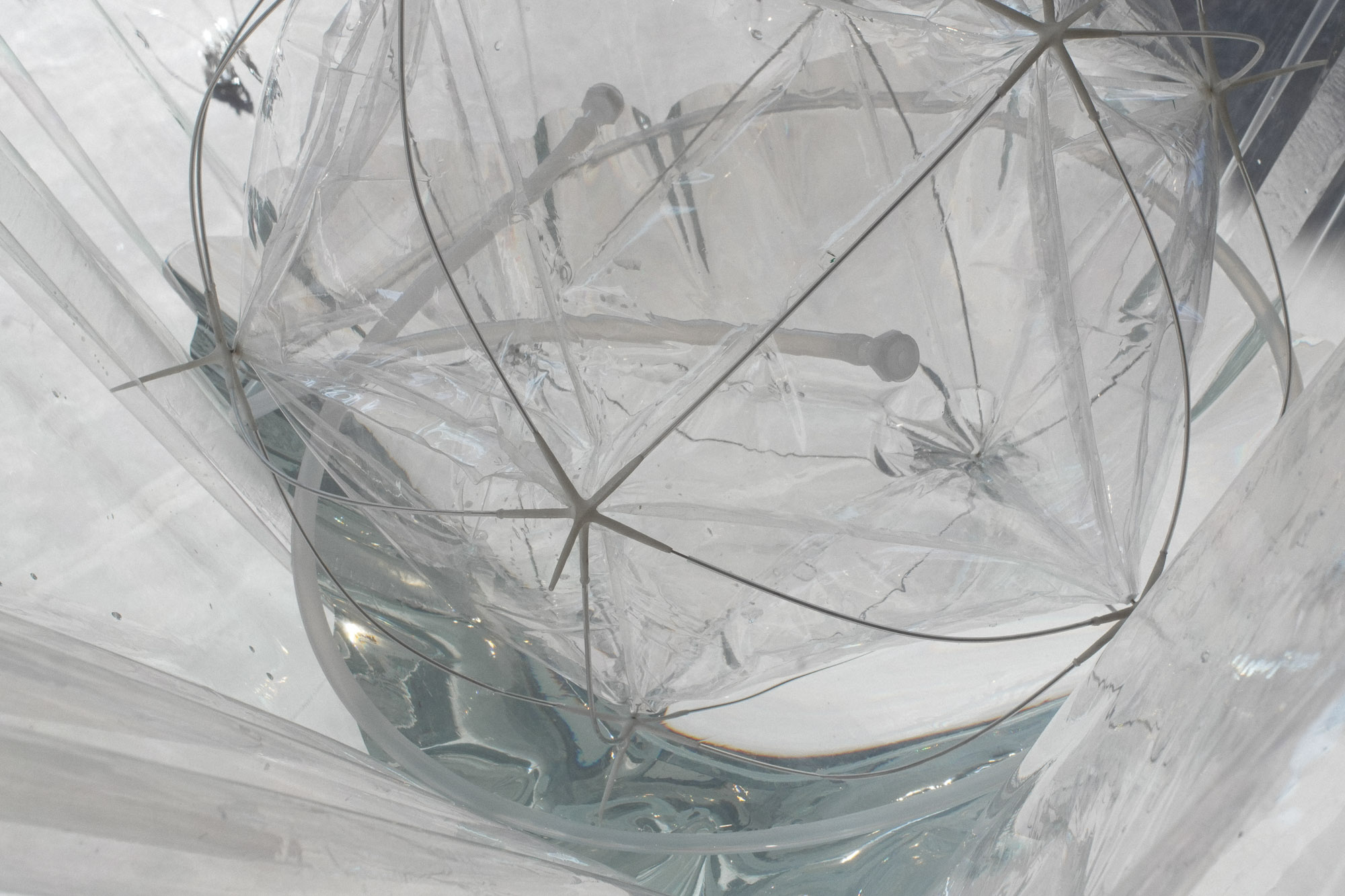
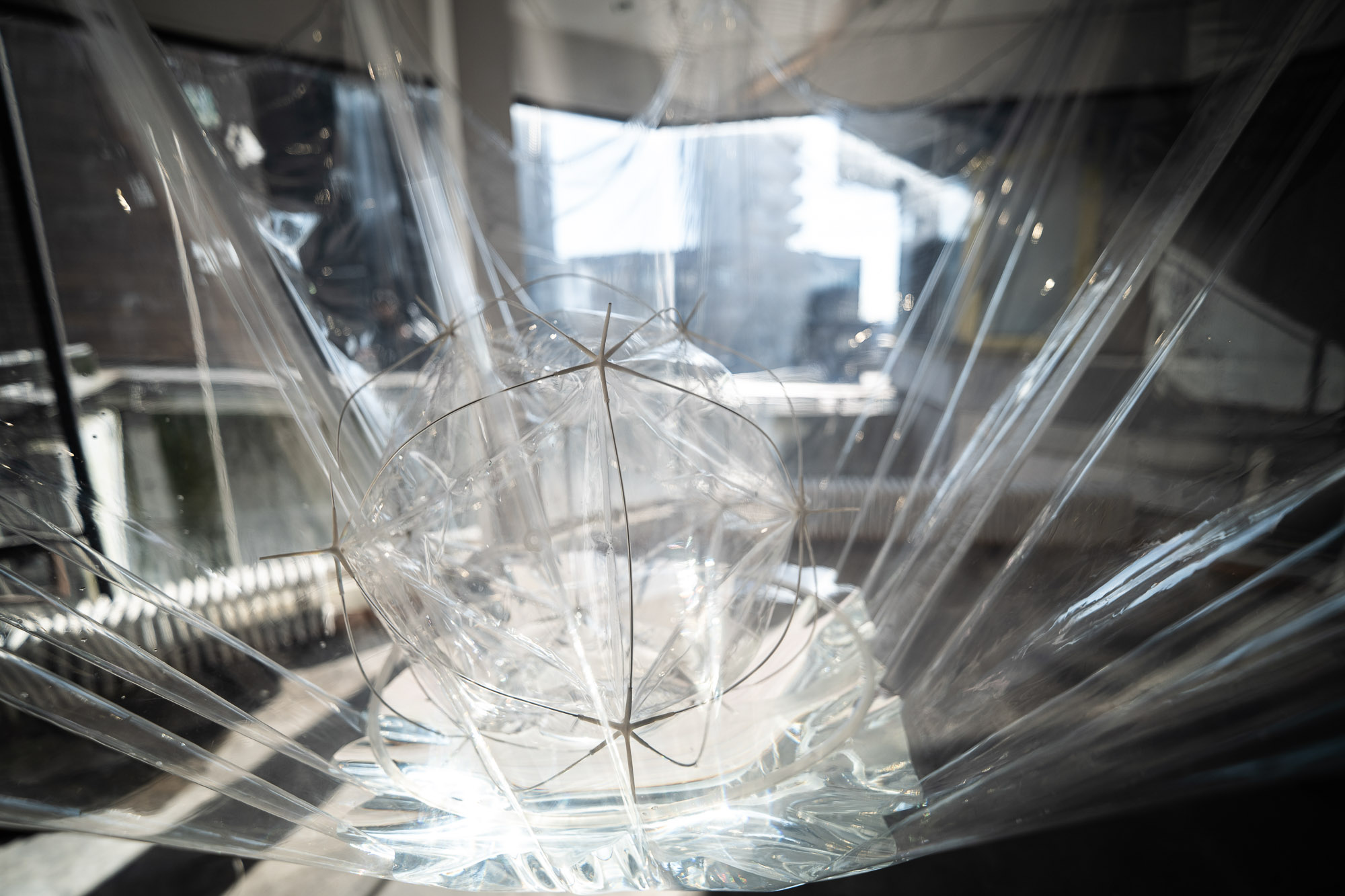
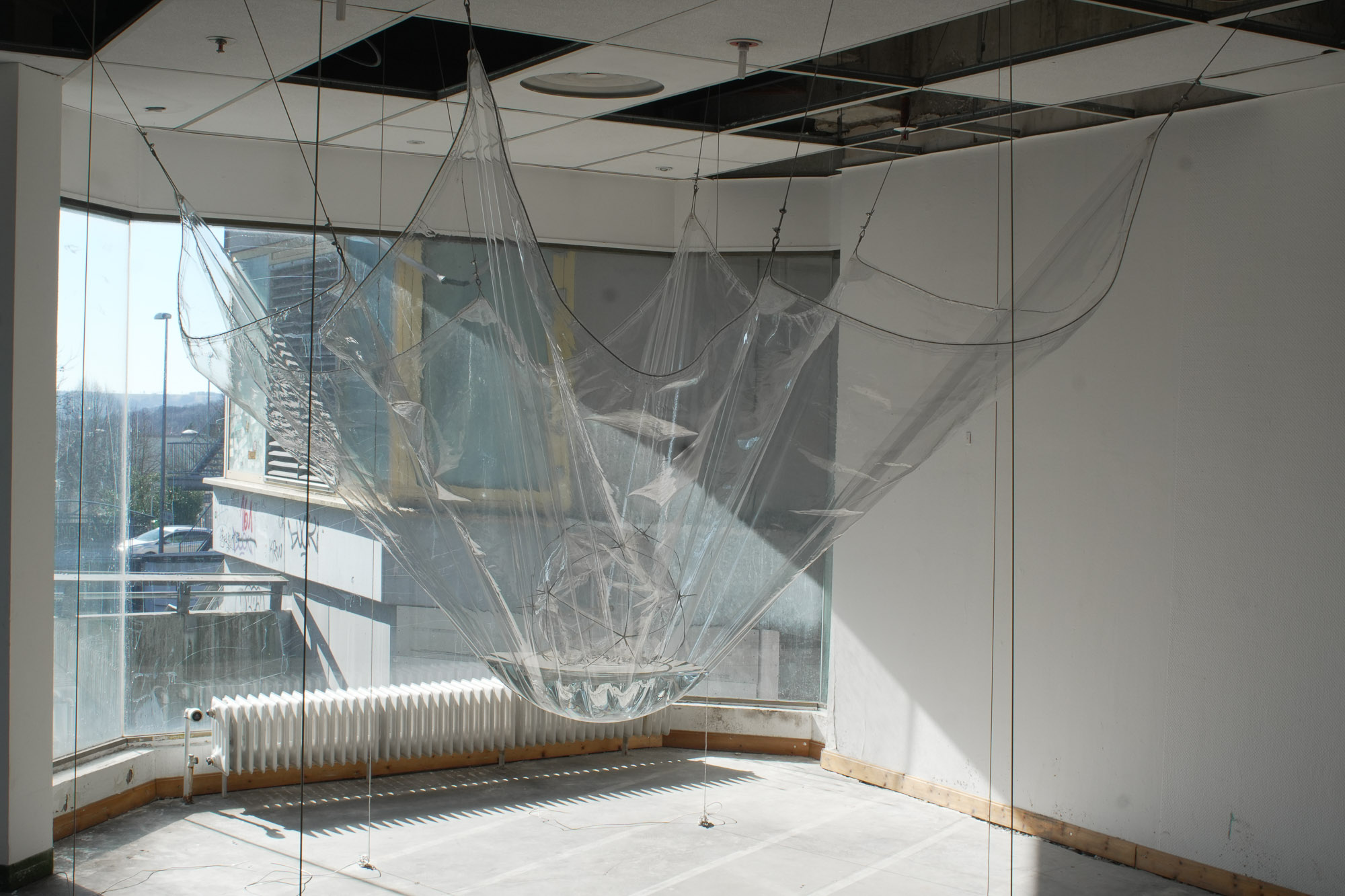
Wetmesh II continues the investigation initiated with Wetmesh I, but in a condensed format that emphasizes material processes over interaction. The work consists of a cubic aluminum frame from which a thermoplastic polyurethane (TPU) membrane is suspended by a system of tension cables. The membrane contains approximately 12 liters of water, whose weight generates continuous deformations and stresses across its surface.
These forces, normally imperceptible, are revealed through a system of polarized filters placed above and below the structure. Light passing through the filters allows the internal stresses of the water and the membrane to be perceived, showing how subtle material variations are registered within the device.
Within the suspended system floats a biomorphic object made of latex and SLA resin. It drifts with the liquid, registering its subtle fluctuations and making visible the internal movements of the membrane.
Unlike its predecessor, Wetmesh II does not rely on direct human interaction. Instead, it operates as an autonomous ecosystem, a minimal device where water, matter, and light expose their own internal negotiations. In this reduction of scale, the work condenses the project’s central concern: to approach water not as a passive medium, but as an active substance that simultaneously records and produces relations.


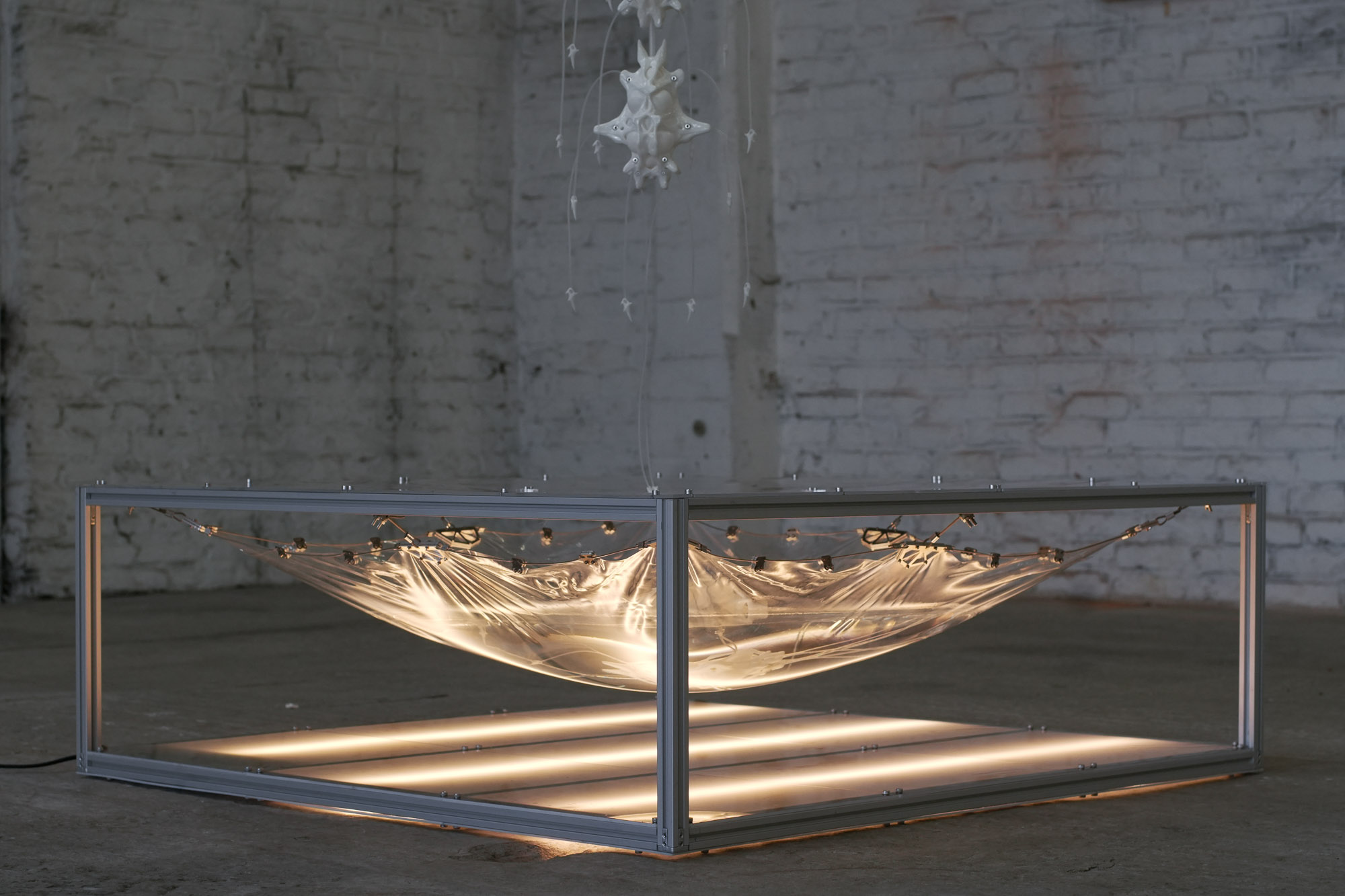
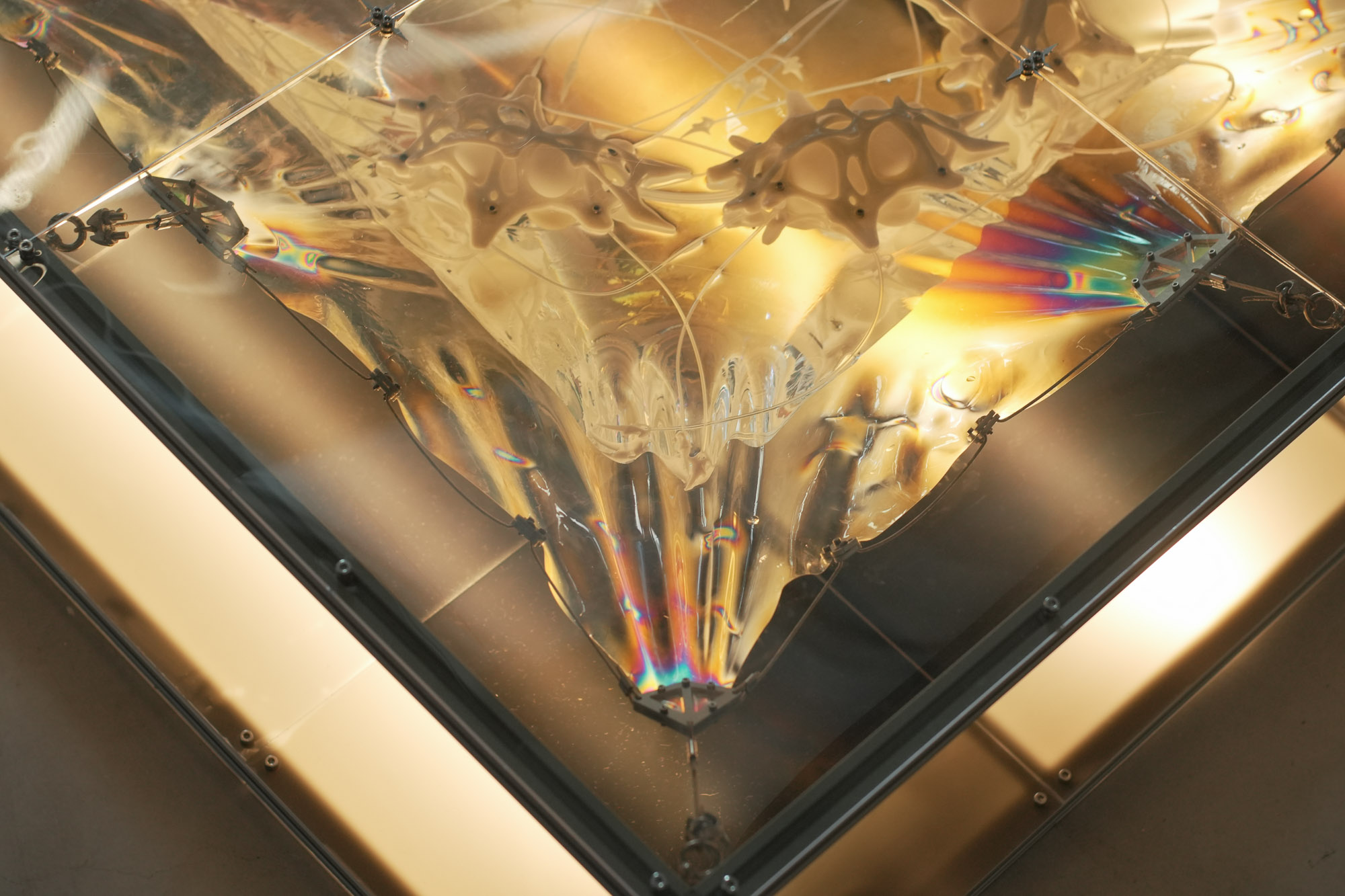
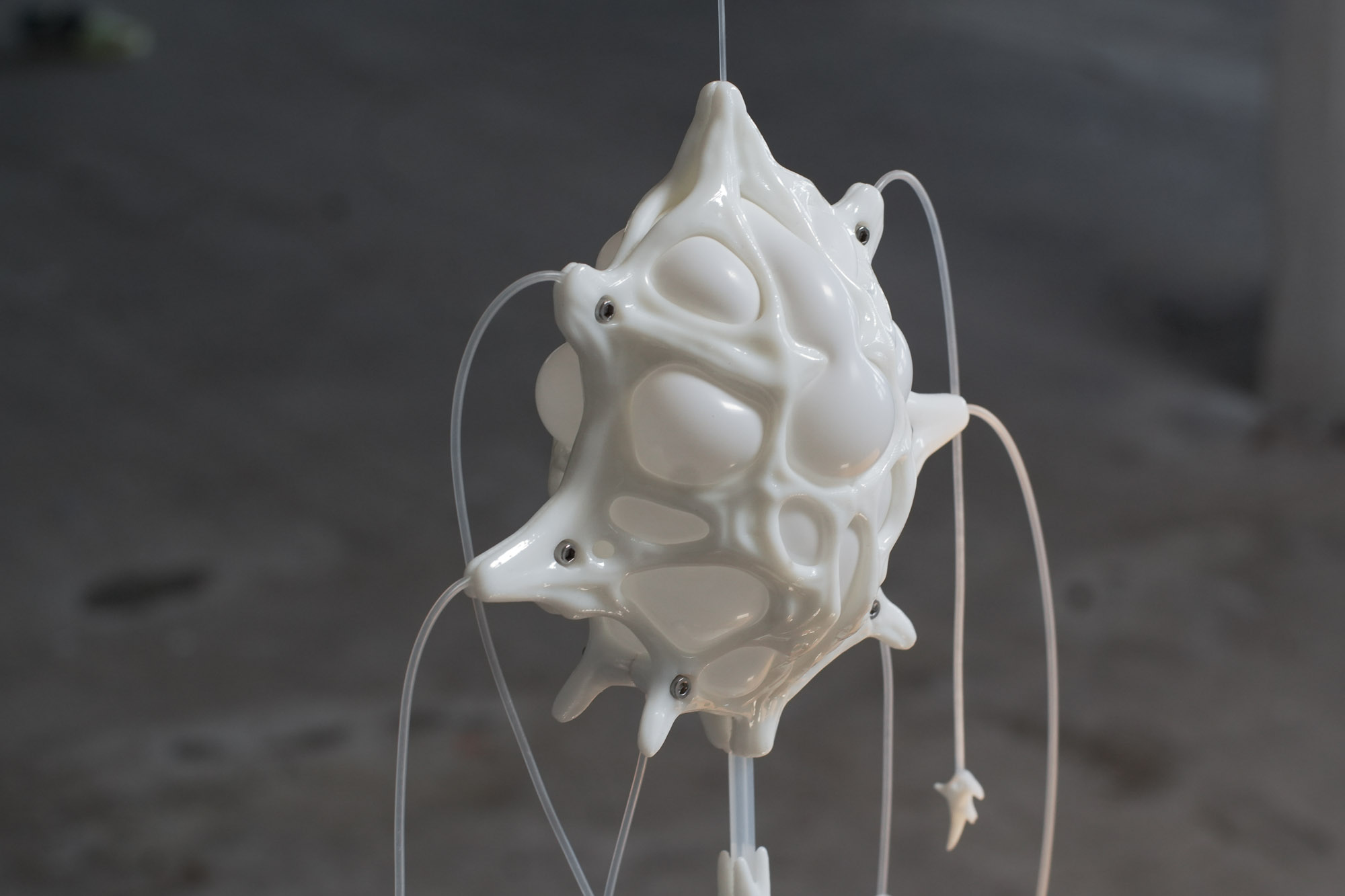
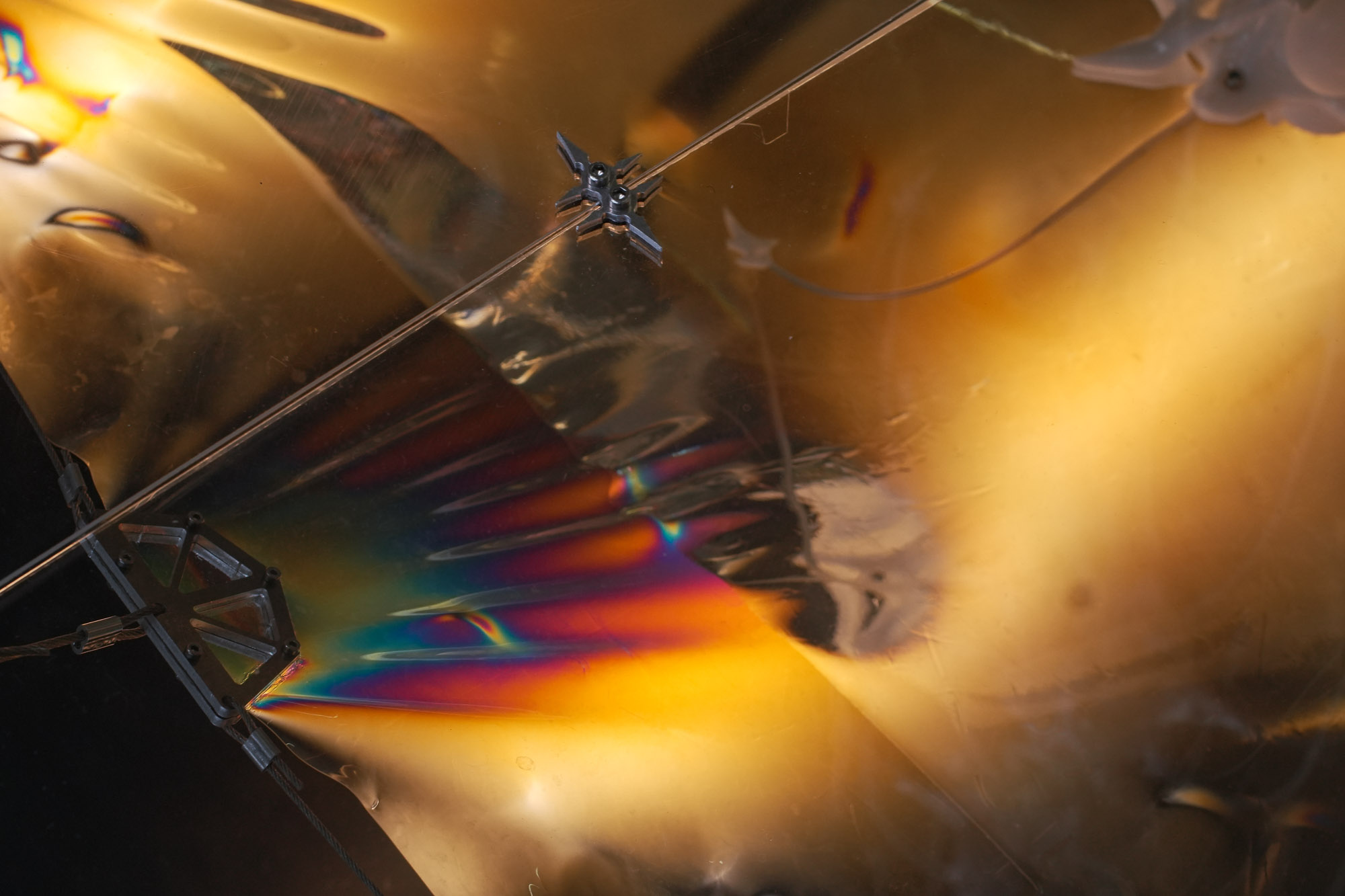
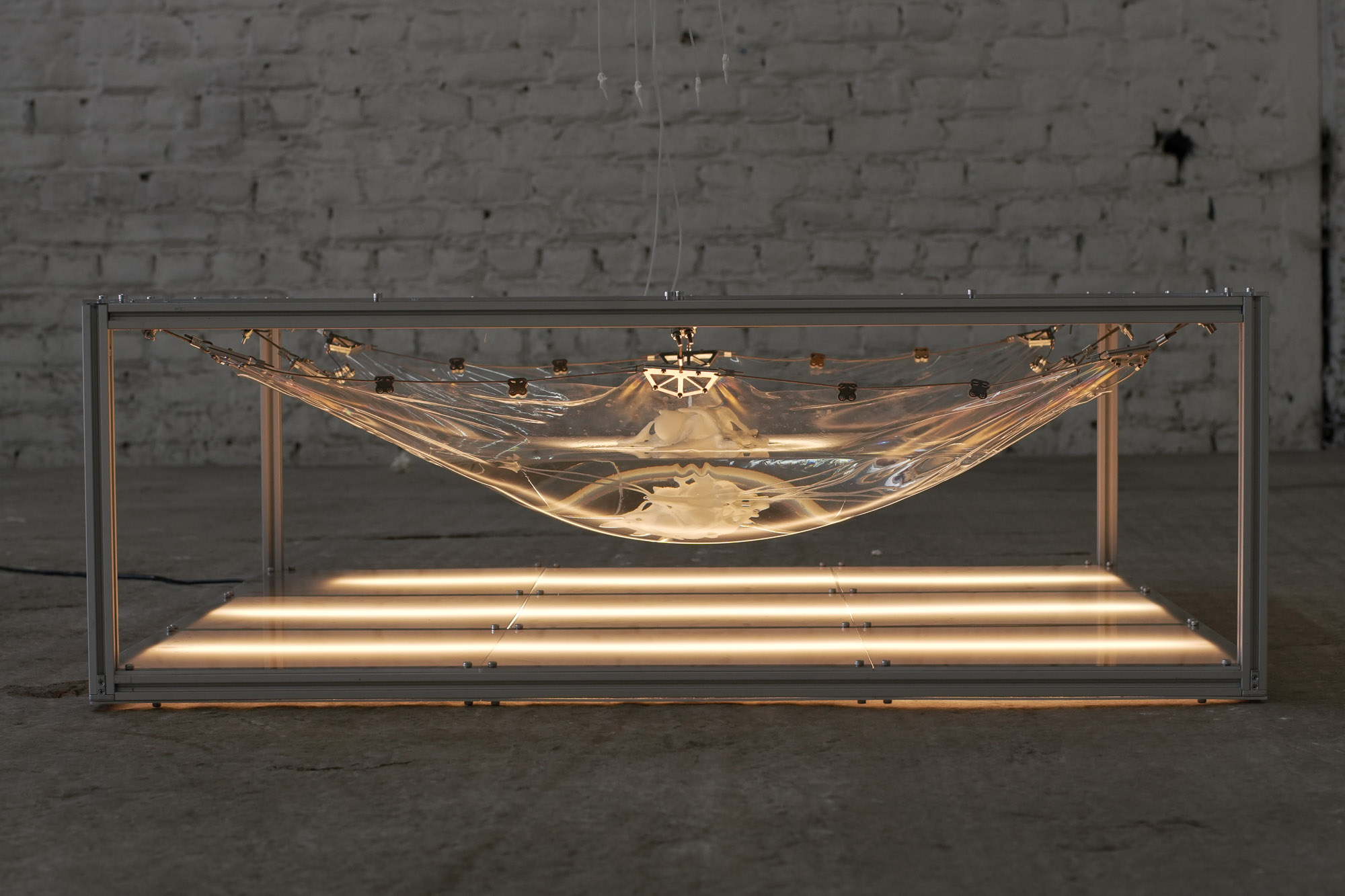
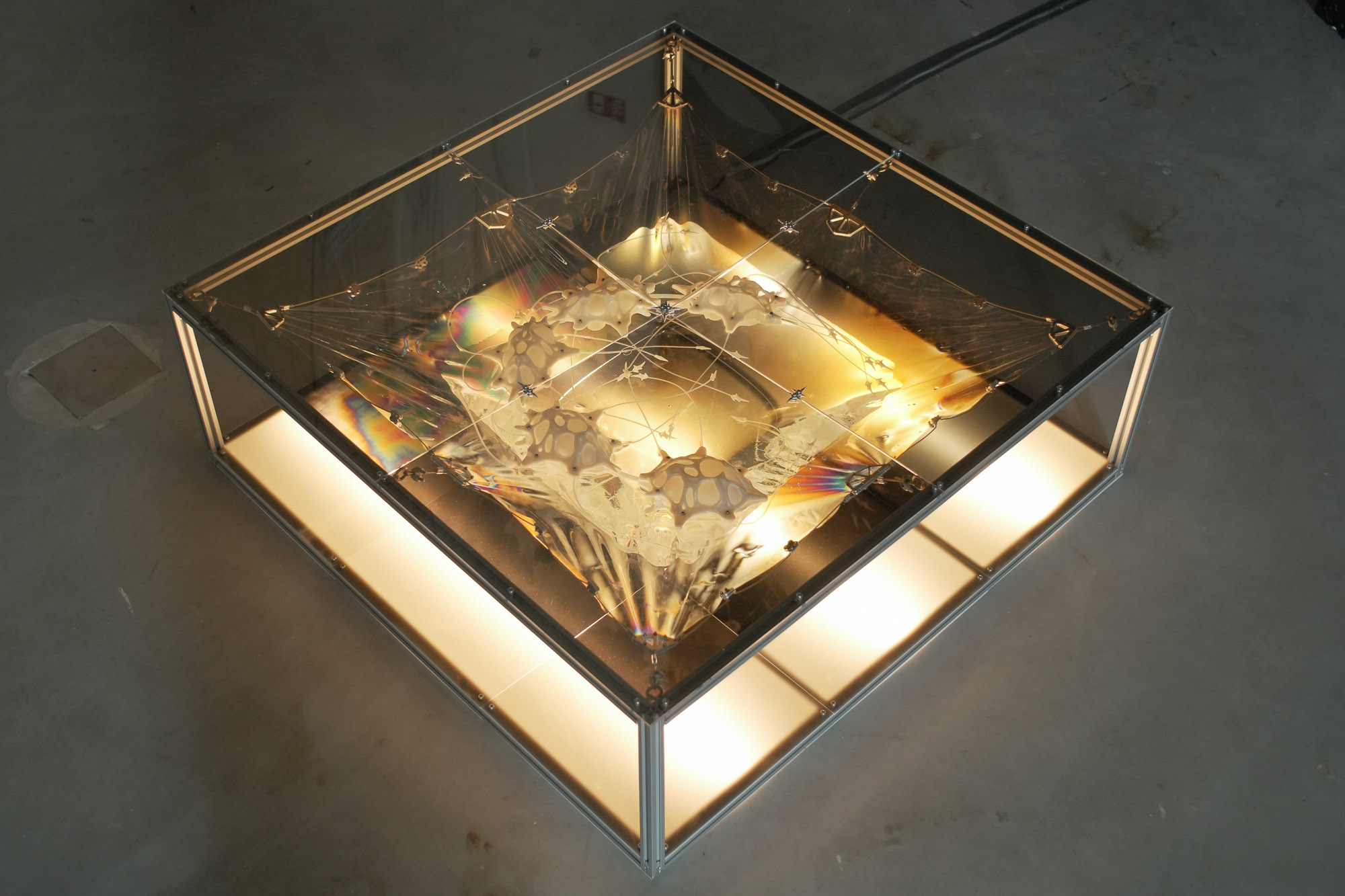
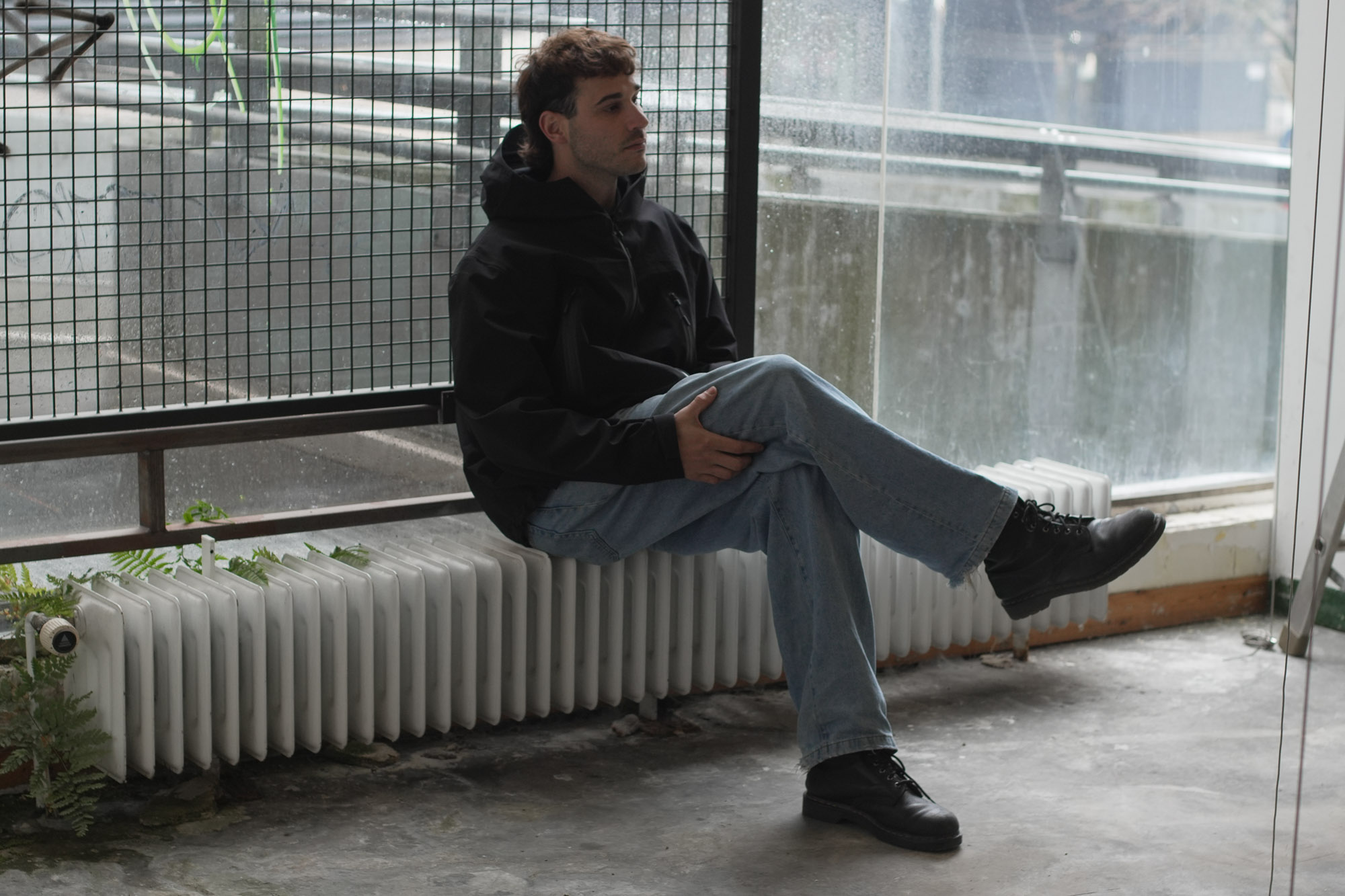
Rafael Soto Acebal (1998, Argentina) is an artist and architect who holds a degree in Architecture from the Faculty of Architecture, Design and Urbanism (FADU–UBA). He is currently pursuing a Master of Arts in Digital Media at the Hochschule für Künste (HfK) in Bremen, Germany. His multidisciplinary practice spans spatial installations, kinetic sculpture, and media-based works, bridging digital and analog realms to create speculative scenarios that explore the relationships between human / non-human, technology and matter.
My practice explores invisible structures and hidden systems, approaching disorder and noise as potential origins of new forms of organization. It investigates alternative modes of communication, entropy, and a personal understanding of tension. These explorations materialize in kinetic machines, optical devices, tensile structures, biomorphic sculptures, video works, floating devices, and crystallization processes.
I work across natural and synthetic matter, combining manual, digital, and computational processes. These elements converge in changing configurations, where projects evolve through non-linear dialogues between material agency, technique, and form.
I draw from Michel Serres and Timothy Morton, whose reflections on noise, systems, and interobjectivity inform my speculative approach to inhabiting and relating with the non-human. Building on these ideas, I conceive space as an open, flexible, and porous system, where coexistence and interference replace the logic of fixed control.
These ideas take form in works such as Wetmesh, a suspended textile installation that holds water inside and functions as a speculative communication system. Through tensile lines, participants interact with each other and with the piece, generating a flow of tensions and liquid exchanges. A floating device interferes with that balance, introducing a ‘parasitic noise’ that disrupts the system. The work proposes water as a soft infrastructure for inhabiting and relating, where fluidity articulates alternative forms of connection.
My work does not aim to provide explanations, but to open spaces for encounter — where the viewer may take something from the piece, and the piece itself is transformed by their presence. Today, my practice expands these ideas through the development of devices that not only disrupt, but begin to act as autonomous entities with their own agency. I am interested in further exploring speculative forms of inhabiting, where the aquatic, the parasitic, and the non-human intertwine to propose alternative modes of relation and coexistence.